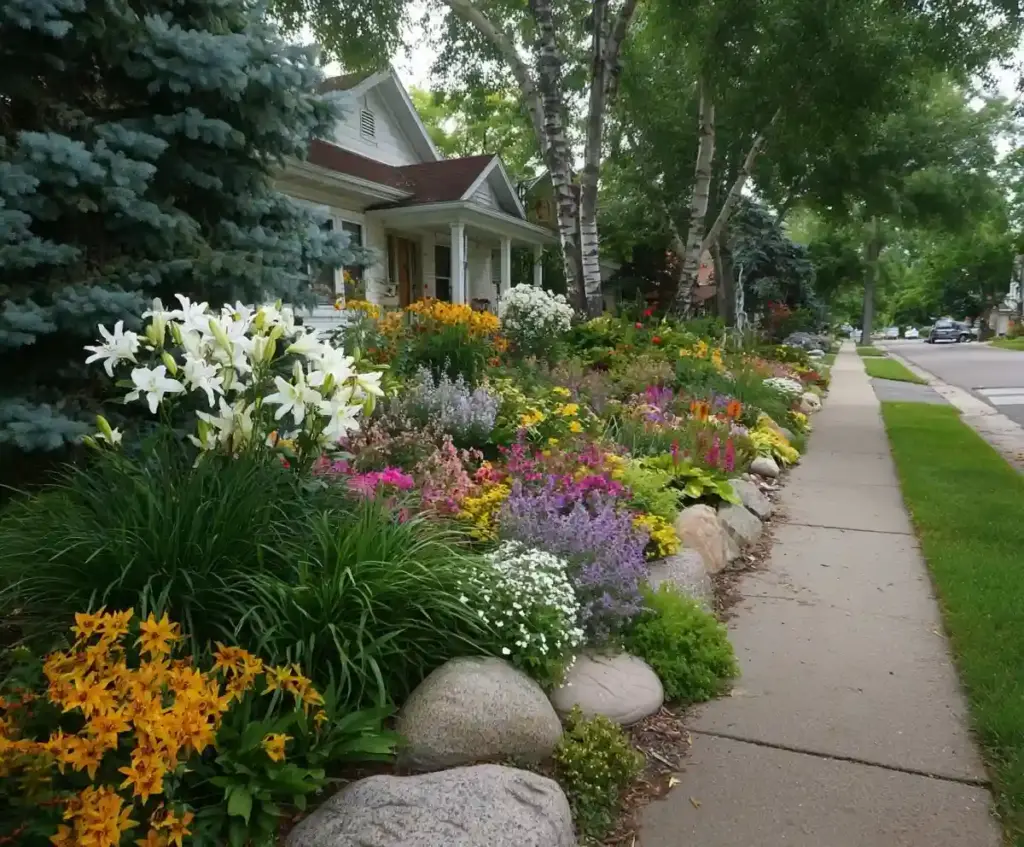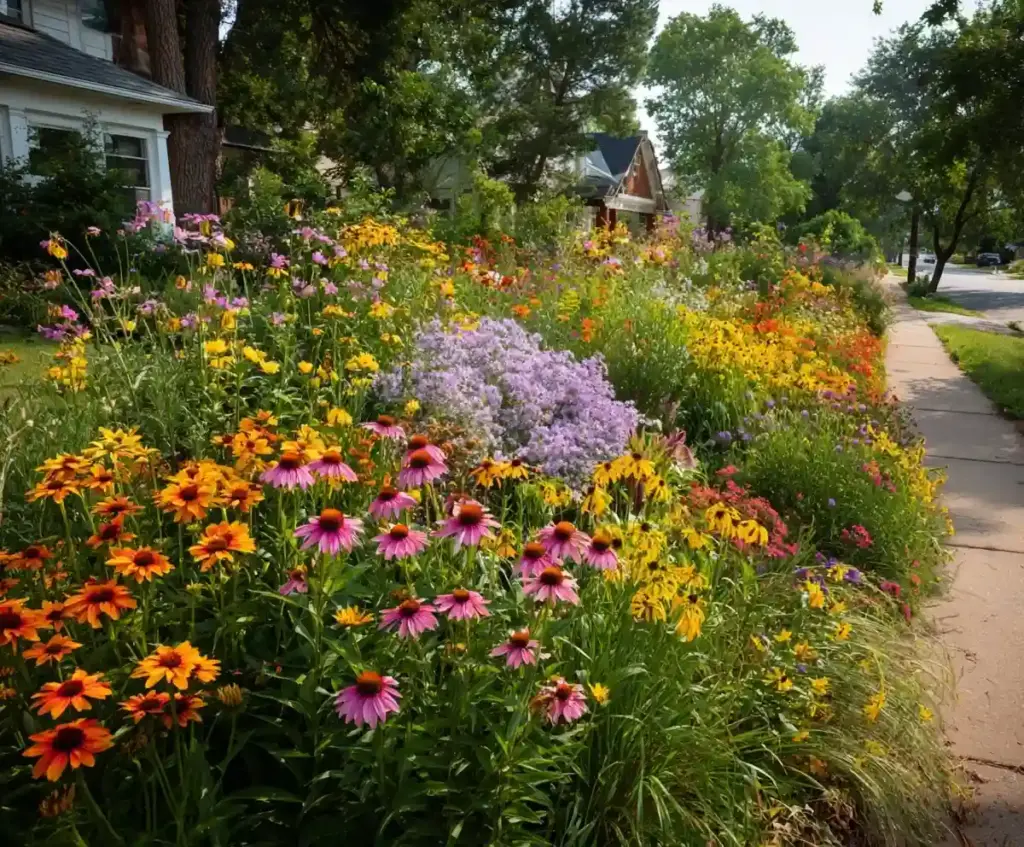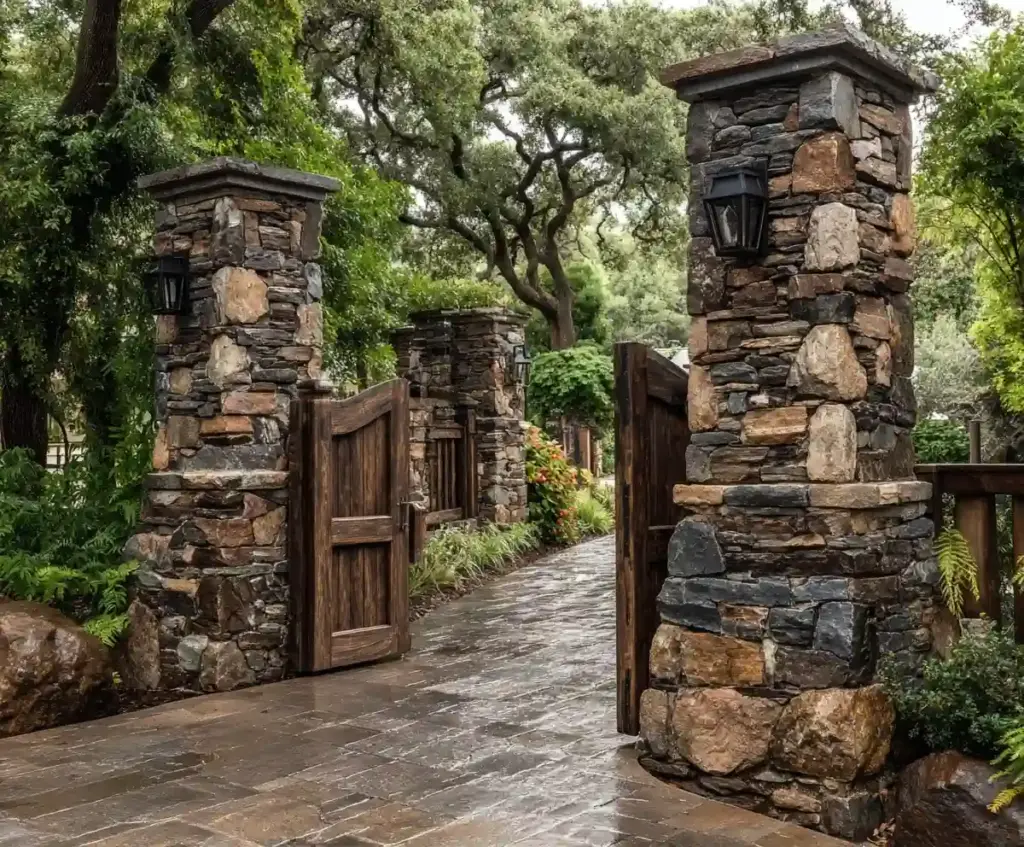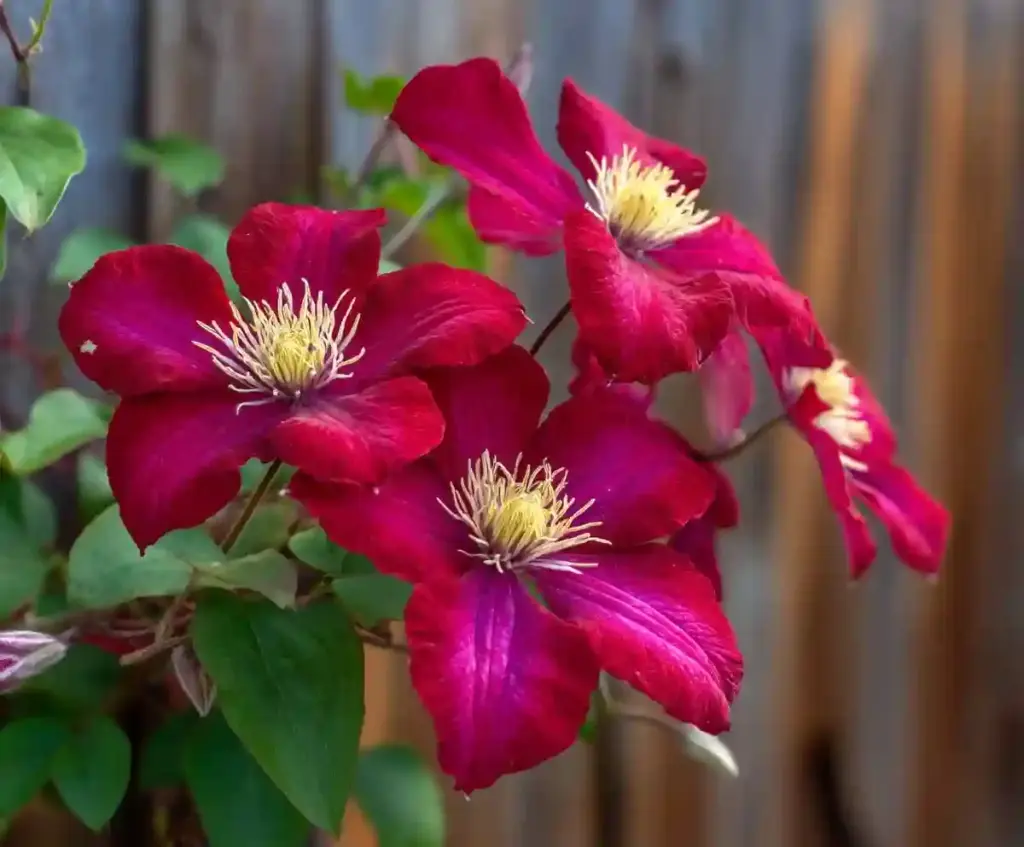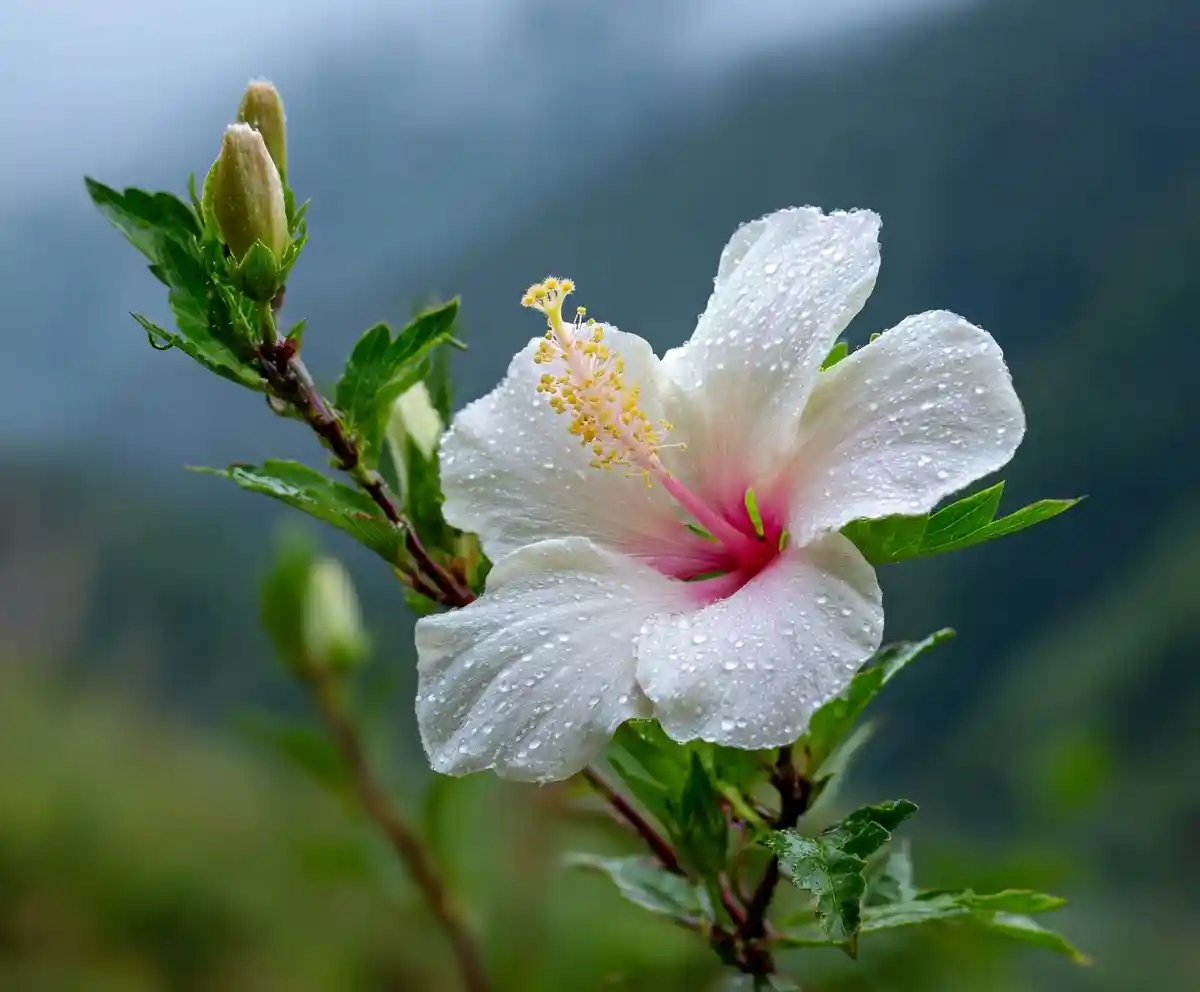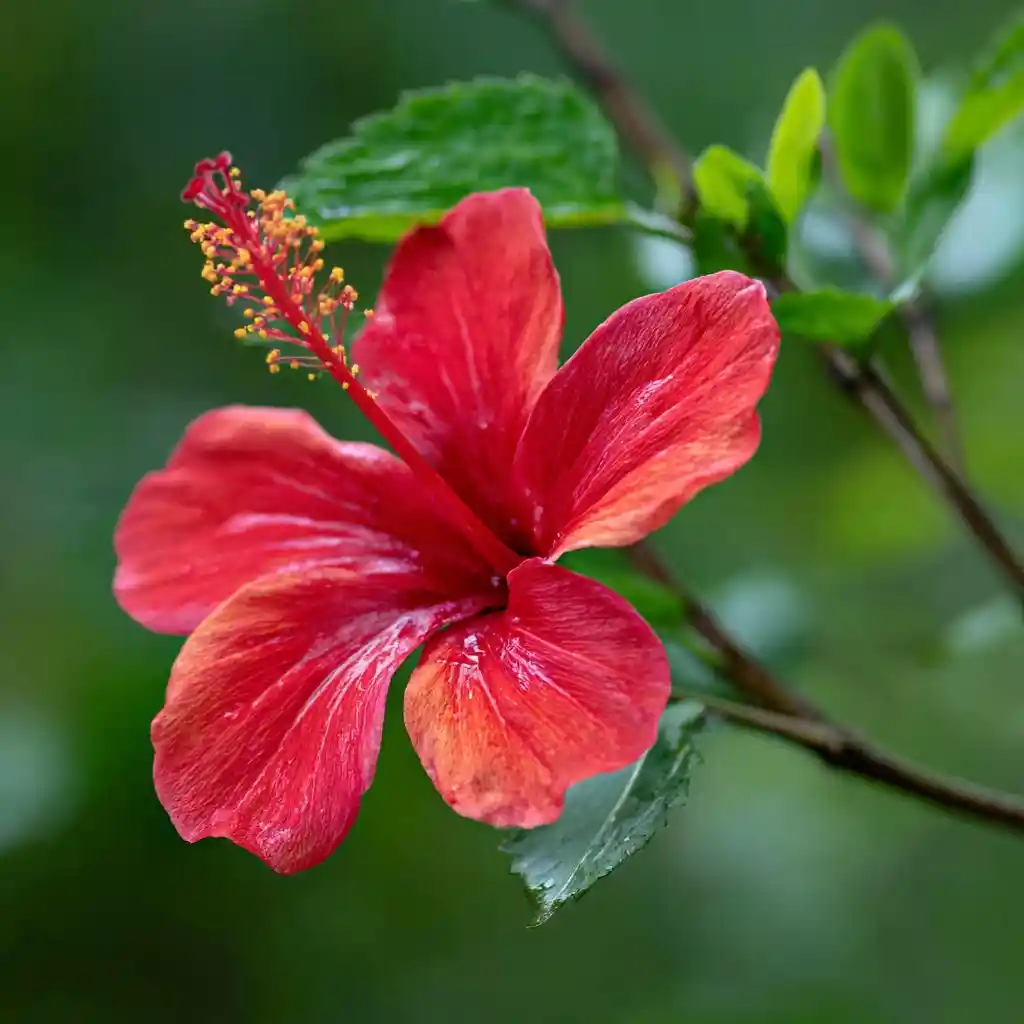The hibiscus flower is a showstopper in any garden, known for its bold colors, dramatic petals, and tropical flair. Whether you’re working with a small patio container or planning a lush landscape, there’s a hibiscus variety that fits your needs. From compact shrubs to towering perennials, these plants offer more than just beauty—they also attract pollinators like hummingbirds and butterflies.
In this guide, we’ll introduce you to types of hibiscus flowers for gardens that thrive in various climates and conditions. You’ll find hardy picks for cold zones and tropical stunners for warmer regions. Whether you prefer classic reds or unique blue-tinged blooms, there’s a hibiscus flower waiting to brighten your outdoor space.
Table of Contents
🌿 1. Swamp Hibiscus
If you love a bold, tropical look in your yard, the swamp hibiscus is a vibrant choice. This variety is known for its eye-catching, deep red blooms that can span six inches or more. As a native wetland plant, it’s well-suited for rain gardens, pond edges, and other moist, sunny spots where drainage may be tricky for other species.
Growing over six feet tall, this hibiscus flower thrives in full to partial sunlight and needs consistently moist soil to reach its full potential. In colder zones, adding mulch in late fall can help protect its roots during the winter months. The swamp hibiscus also attracts butterflies and bees, making it a pollinator-friendly addition to any garden.
Quick Facts:
- Botanical Name: Hibiscus coccineus
- Zones: 6–9
- Height: 6+ ft.
- Light: Full sun to partial shade
- Soil: Sand, clay, or loam (moist)
- Watering: Keep soil evenly moist
🌸 2. Cotton Rose

The cotton rose brings a magical transformation to your garden with its blooms that change color as they mature—from white in the morning to pink by afternoon, and a rich red by evening. This fast-growing shrub can reach up to 15 feet tall, giving it a tree-like presence in larger landscapes.
This hibiscus flower variety is known for its fuzzy seed pods and long-lasting blooms that appear from late summer into fall. It’s deer-resistant, low-maintenance, and ideal for gardeners who want a dramatic centerpiece without constant upkeep. For best results, prune in late winter or early spring to encourage fresh growth and more flowers.
Quick Facts:
- Botanical Name: Hibiscus mutabilis
- Zones: 7–11
- Height: 6–15 ft.
- Light: Full sun to partial shade
- Soil: Loamy and well-drained
- Watering: Keep soil consistently moist
🌺 3. Rose of Sharon
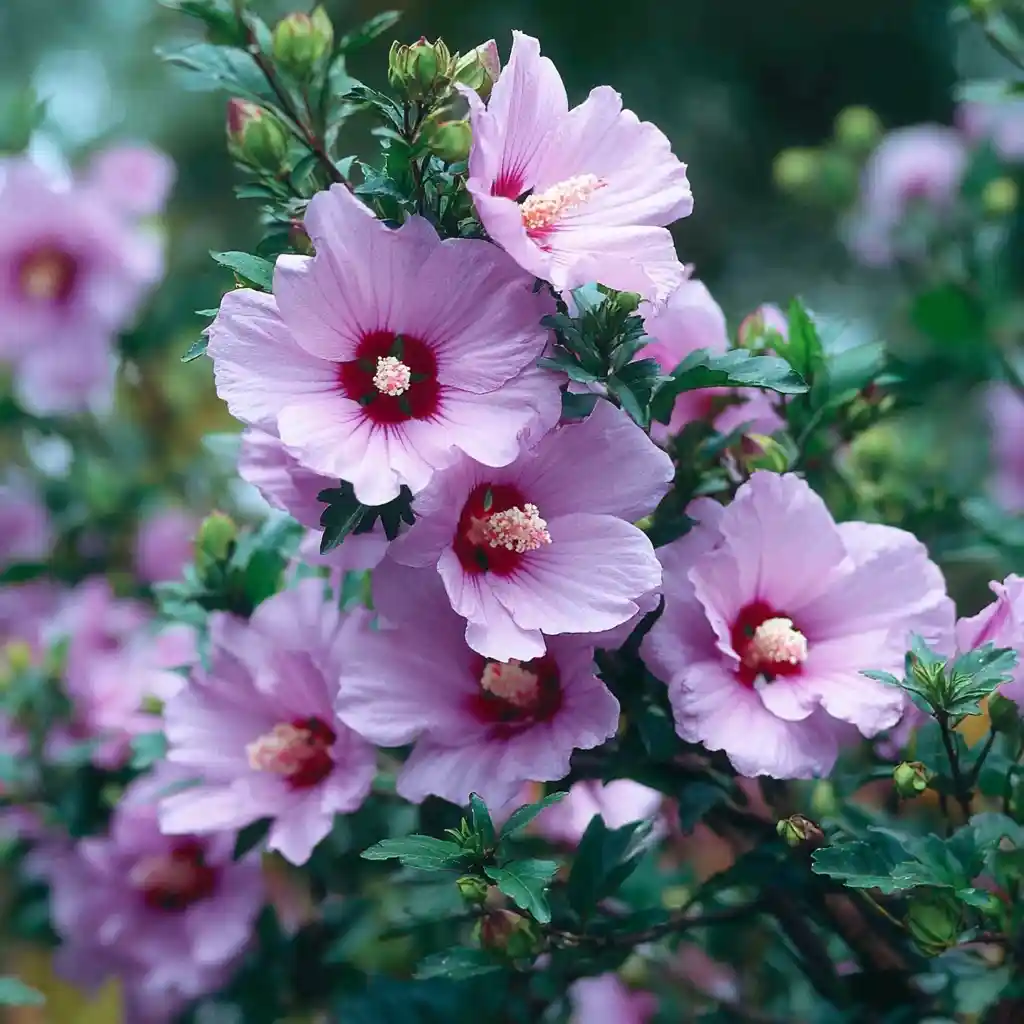
The Rose of Sharon is one of the most versatile and widely grown hibiscus varieties. This upright shrub features trumpet-shaped blooms in shades of pink, lavender, red, blue, and white—often with a contrasting dark center that adds visual drama. Its long bloom period, from midsummer through fall, makes it a favorite among gardeners seeking steady color.
Unlike tropical varieties, this hibiscus flower is cold-hardy and can handle zones as low as 5. It naturally grows in a vase shape but can be pruned into a small tree. Be aware, though—Rose of Sharon tends to self-seed, so you may need to manage volunteer plants if you want to keep your garden tidy.
Quick Facts:
- Botanical Name: Hibiscus syriacus
- Zones: 5–8
- Height: 8–12 ft.
- Light: Full sun to partial shade
- Soil: Moist, well-drained
- Watering: Keep soil moist; established plants tolerate light drought
💙 4. Rose of Sharon ‘Blue Chiffon’

For gardeners seeking a truly unique hibiscus flower, the ‘Blue Chiffon’ cultivar delivers with its pale blue, semi-double blooms that have a soft, lacy appearance. These delicate-looking flowers are more than just pretty—they bloom from mid-summer into fall and draw pollinators like bees and butterflies.
This variety has a tall, rounded growth habit and is well-suited as a specimen plant or part of a flowering hedge. It performs well in a range of soils as long as they’re well-drained. Like many Rose of Sharon types, ‘Blue Chiffon’ is fairly drought-tolerant once established but benefits from regular watering during dry spells.
Quick Facts:
- Botanical Name: Hibiscus syriacus ‘Blue Chiffon’
- Zones: 5–9
- Height: 8–12 ft.
- Light: Full sun to partial shade
- Soil: Moist, well-drained
- Watering: Maintain moist soil, especially during hot months
🍭 5. Rose of Sharon ‘Sugar Tip’
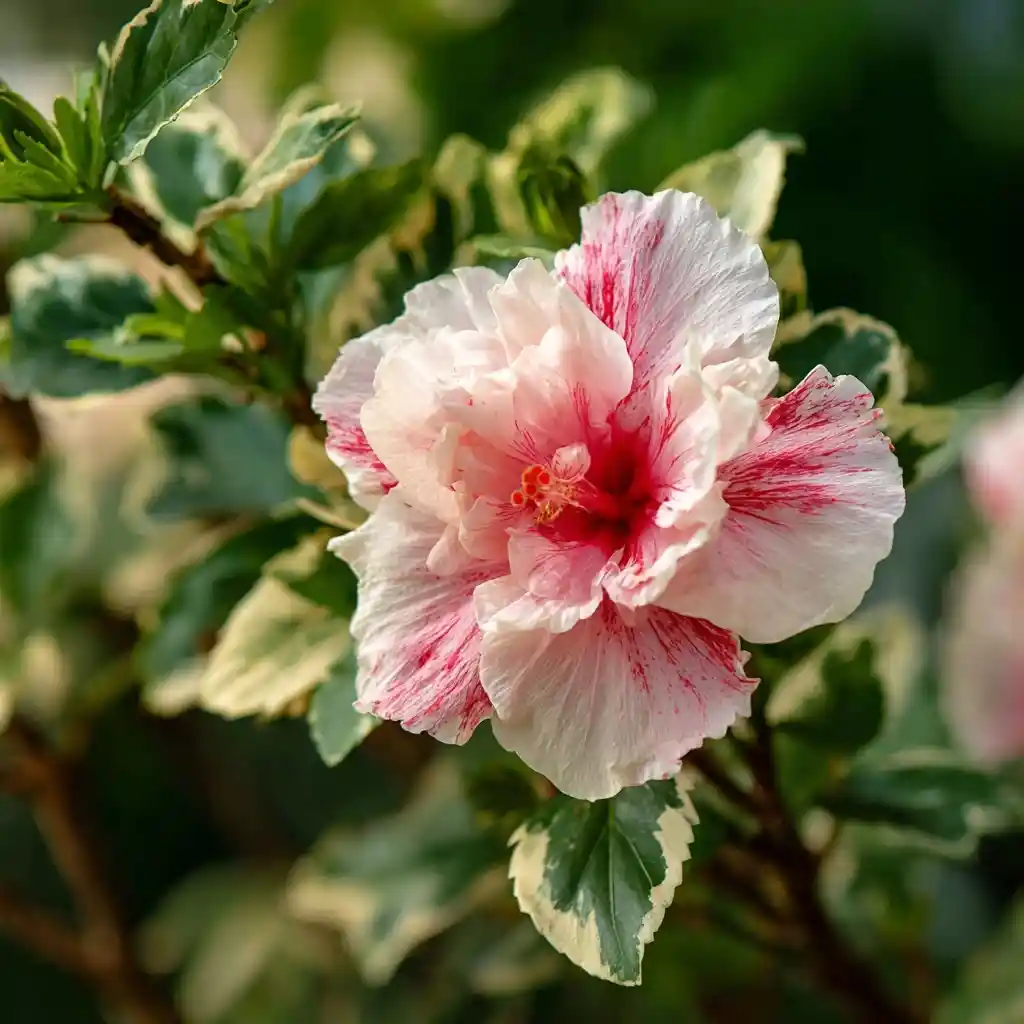
The ‘Sugar Tip’ is a standout hibiscus flower cultivar that combines beauty and practicality. Its soft pink, double-petaled blooms are accented with deep red centers, giving them a charming, candy-like appearance. But the real eye-catcher is the plant’s foliage—its green leaves are edged with creamy white variegation that adds color even when it’s not in bloom.
More compact than traditional Rose of Sharon varieties, ‘Sugar Tip’ grows to about six feet, making it perfect for smaller gardens, borders, or large containers. This sterile cultivar won’t self-seed, so you won’t have to worry about unwanted seedlings taking over your garden beds.
Quick Facts:
- Botanical Name: Hibiscus syriacus ‘Sugar Tip’
- Zones: 5–8
- Height: 5–6 ft.
- Light: Full sun
- Soil: Moist, well-drained
- Watering: Water regularly to keep soil evenly moist
❤️ 6. Rose of Sharon ‘Red Heart’

If you’re after classic elegance with a bold twist, the ‘Red Heart’ hibiscus is a top contender. This variety of hibiscus flower showcases pure white petals that frame a striking, deep red center—hence the name. The contrast creates a dramatic effect in the garden, especially when planted en masse or as a hedge.
Each bloom lasts just one day, but the plant produces flowers continuously from midsummer through fall. Thanks to its strong stems and upright habit, ‘Red Heart’ works well in foundation plantings or privacy screens. It prefers full sun and rewards attentive watering with vibrant, healthy blooms.
Quick Facts:
- Botanical Name: Hibiscus syriacus ‘Red Heart’
- Zones: 5–9
- Height: 8–10 ft.
- Light: Full sun to partial shade
- Soil: Rich, well-drained
- Watering: Water deeply and regularly to keep soil moist
🤍 7. Rose of Sharon ‘White Chiffon’
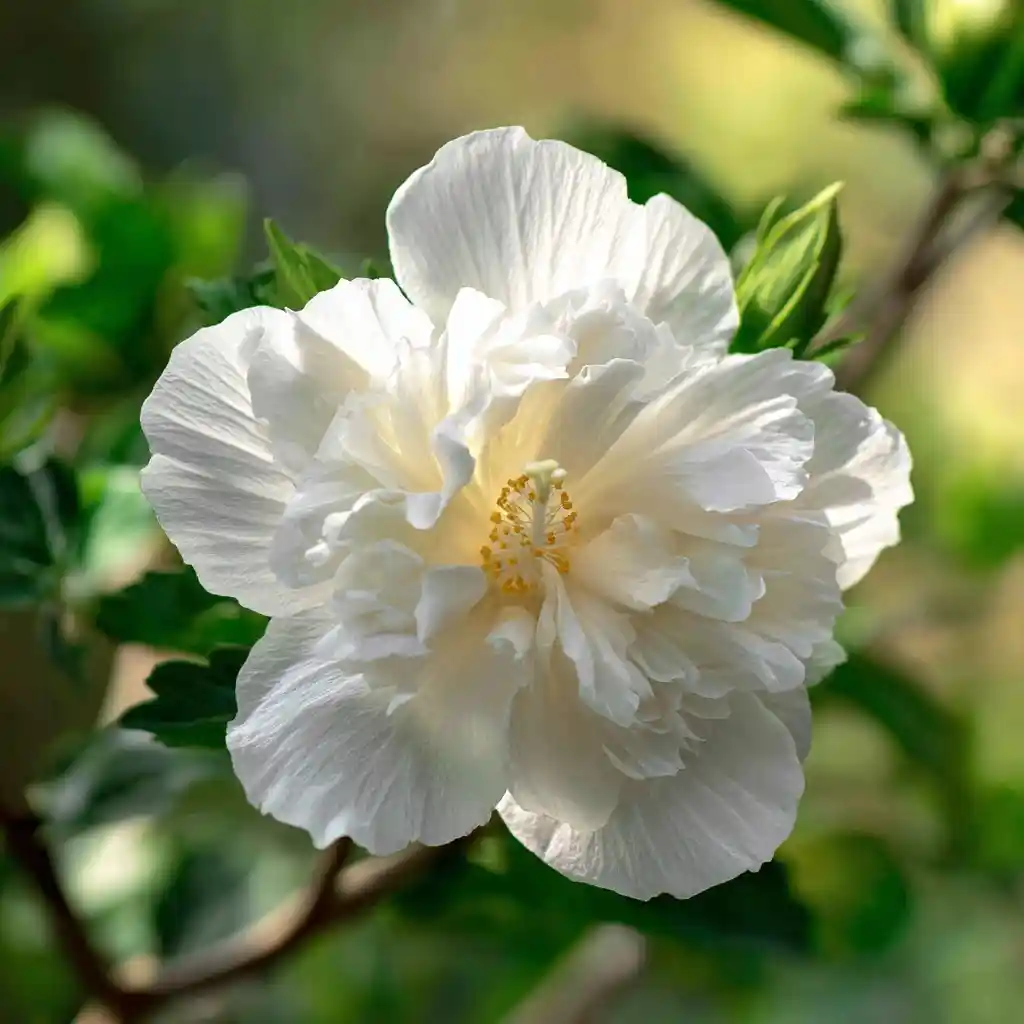
The ‘White Chiffon’ is a clean, elegant addition to any garden, offering snowy white blooms with a subtle ruffle of inner petals for added texture. Unlike other varieties with colored centers, this hibiscus flower is pure white from edge to core, making it a standout choice for serene, monochrome garden designs or mixed flowering borders.
‘White Chiffon’ is heat- and drought-tolerant once established, yet still thrives best in moist, well-drained soil. Its upright growth makes it ideal for hedges, privacy screens, or as a centerpiece in large planting beds. With consistent sun and care, it will bloom from midsummer through early fall.
Quick Facts:
- Botanical Name: Hibiscus syriacus ‘White Chiffon’
- Zones: 5–9
- Height: 8–12 ft.
- Light: Full sun to partial shade
- Soil: Well-drained, fertile soil
- Watering: Maintain evenly moist soil for best performance
🌸 8. Rose of Sharon ‘Aphrodite’
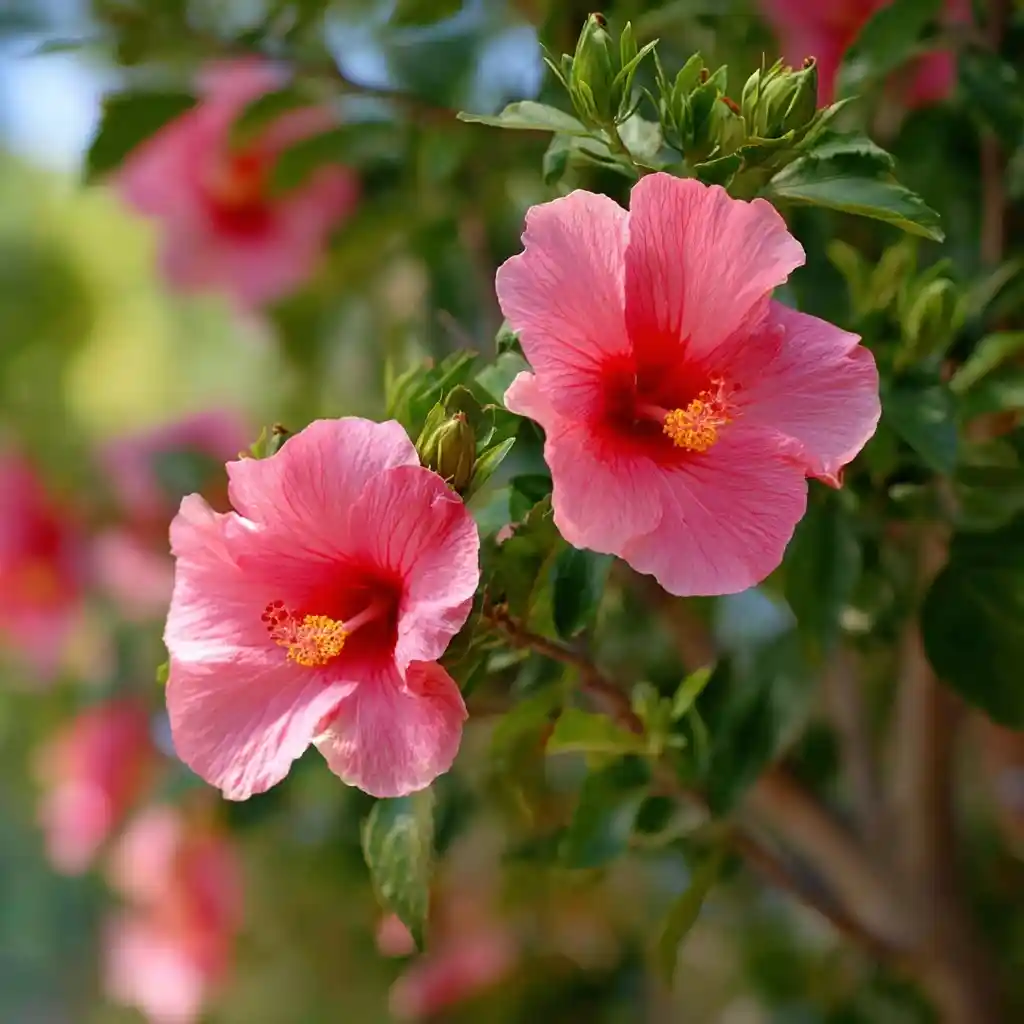
For gardeners seeking a lush, bushy shrub with striking color, ‘Aphrodite’ is a showstopper. This hibiscus flower variety produces large, bright pink blooms with deep red throats that draw in pollinators like bees and hummingbirds. It’s named after the Greek goddess of beauty—and it definitely lives up to its name.
‘Aphrodite’ has a full, rounded growth habit, reaching nearly as wide as it is tall. It doesn’t self-seed, which means no extra weeding or spreading concerns. Plant it in a sunny location and enjoy its vibrant blossoms from midsummer into fall. It’s perfect for borders, foundation plantings, or as a colorful privacy hedge.
Quick Facts:
- Botanical Name: Hibiscus syriacus ‘Aphrodite’
- Zones: 5–8
- Height: 6–10 ft.
- Light: Full sun
- Soil: Well-drained
- Watering: Keep soil evenly moist
💜 9. Rose of Sharon ‘Blue Satin’
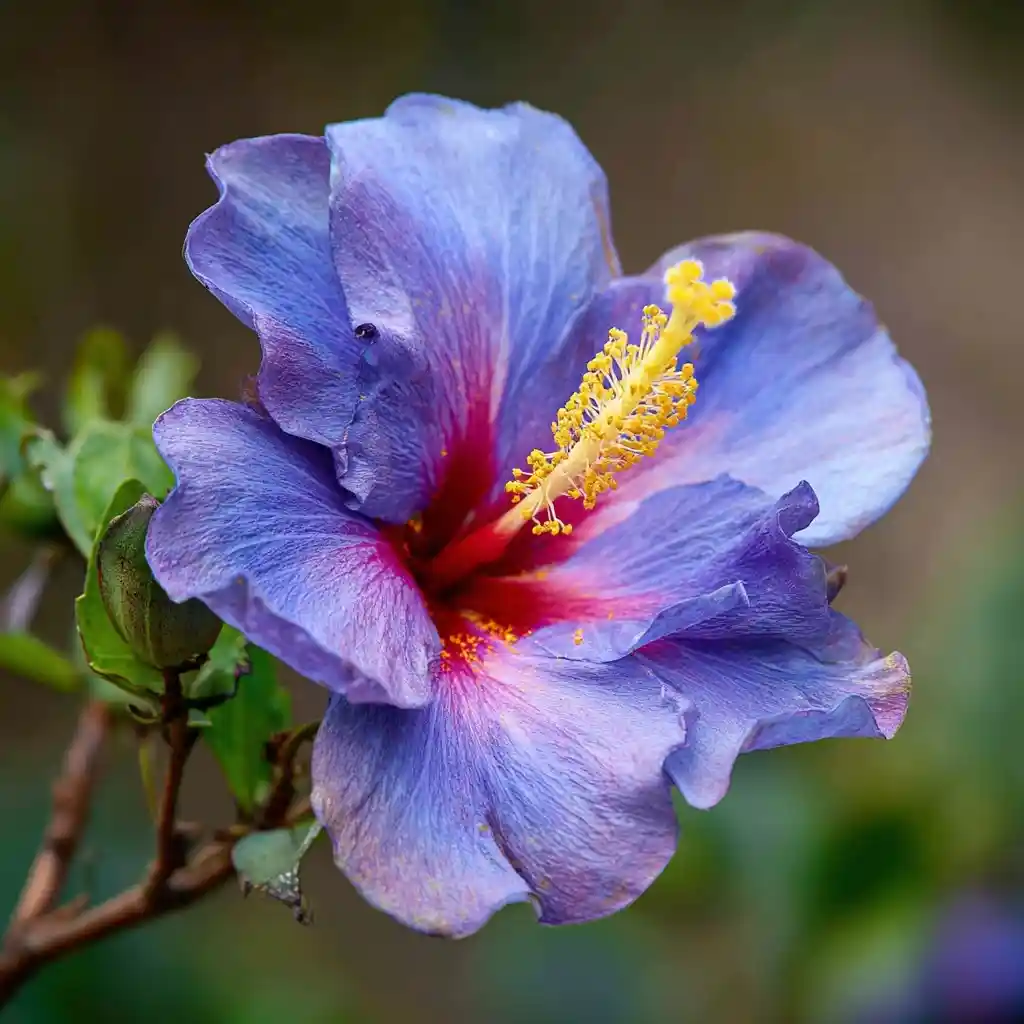
Among the many Rose of Sharon cultivars, ‘Blue Satin’ is prized for its rich, blue-violet petals and deep red center that create a dramatic contrast in the garden. The flowers have a silky texture and bloom profusely from midsummer through fall. As a hibiscus flower, this variety delivers bold color with minimal maintenance.
‘Blue Satin’ grows tall and full, making it ideal for screening, hedging, or as a standalone focal point. It’s drought- and salt-tolerant once established, which makes it a great choice for coastal gardens or areas with less frequent rainfall. Best of all, it’s sterile—so no self-seeding to worry about.
Quick Facts:
- Botanical Name: Hibiscus syriacus ‘Blue Satin’
- Zones: 5–9
- Height: 8–12 ft.
- Light: Full sun to partial shade
- Soil: Well-drained
- Watering: Keep soil evenly moist, especially during hot spells
🫐 10. Rose of Sharon ‘Blueberry Smoothie’

The ‘Blueberry Smoothie’ is a standout among hibiscus shrubs, offering double blooms in shades of violet and blue that look almost surreal in the garden. The full, ruffled petals give the flowers a lush texture, and their color intensity deepens in bright sunlight. As a hibiscus flower, it brings a cool-toned elegance to summer landscapes.
Reaching around eight feet tall, this variety can be shaped into a small tree or left as a full, rounded shrub. It’s seedless, which means it won’t spread uncontrollably, and it thrives in full to partial sun with consistently moist soil. Perfect for adding texture and color to borders or large containers.
Quick Facts:
- Botanical Name: Hibiscus syriacus ‘Blueberry Smoothie’
- Zones: 5–8
- Height: 8 ft.
- Light: Full sun to partial shade
- Soil: Moist, well-drained
- Watering: Deep watering to maintain soil moisture
💜 11. Rose of Sharon ‘Lavender Chiffon’
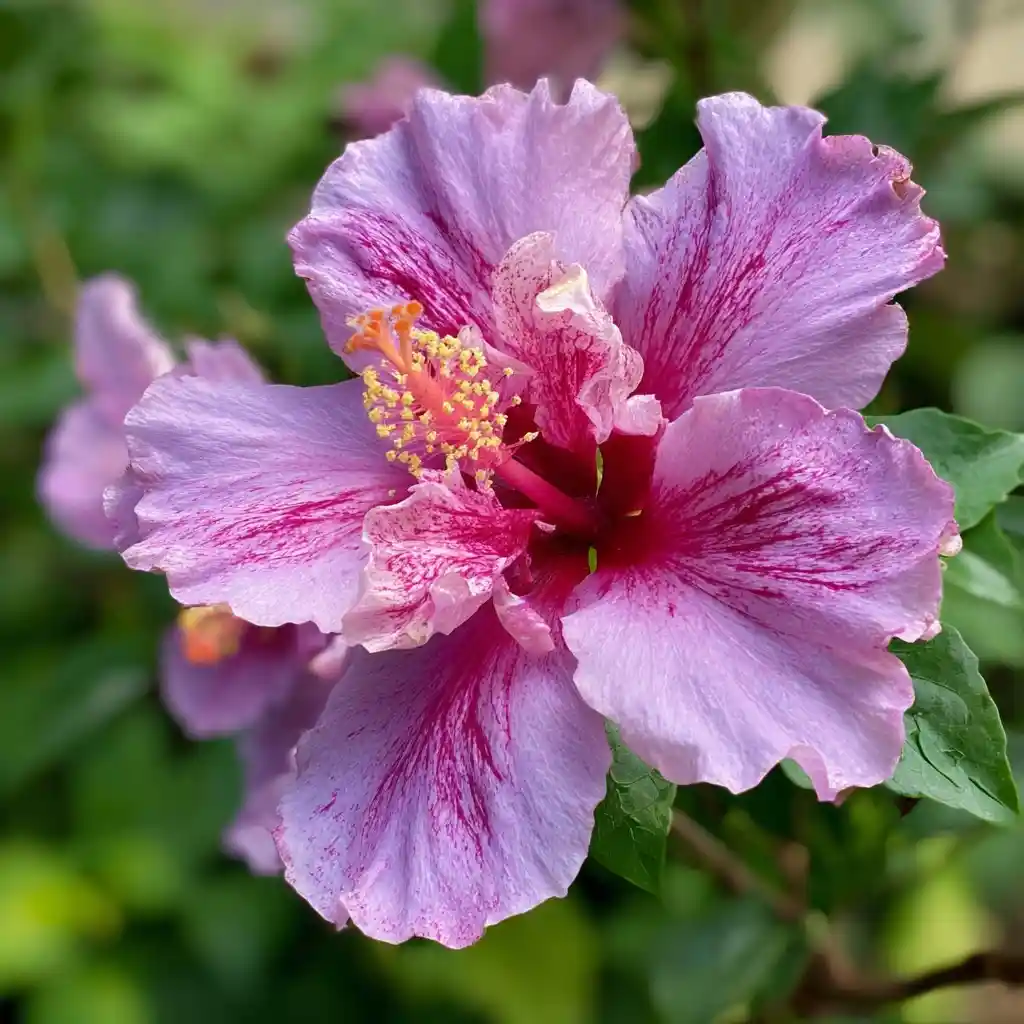
With its soft purple petals and delicate inner ruffles, ‘Lavender Chiffon’ adds a refined, romantic touch to any garden. This hibiscus flower blooms in abundance from midsummer to fall, offering semi-double blossoms with faint red veining that deepens their visual appeal.
Unlike some taller, lankier varieties, ‘Lavender Chiffon’ grows into a full, bushy shrub, making it excellent for informal hedges or privacy borders. It’s also seedless, so you won’t have to worry about controlling unwanted seedlings. Prune it in early spring to shape the plant or allow it to grow naturally for a softer look.
Quick Facts:
- Botanical Name: Hibiscus syriacus ‘Lavender Chiffon’
- Zones: 5–9
- Height: 8–12 ft.
- Light: Full sun to partial shade
- Soil: Moist, rich, well-drained
- Watering: Keep soil consistently moist
🌼 12. Rose of Sharon ‘Lil Kim’
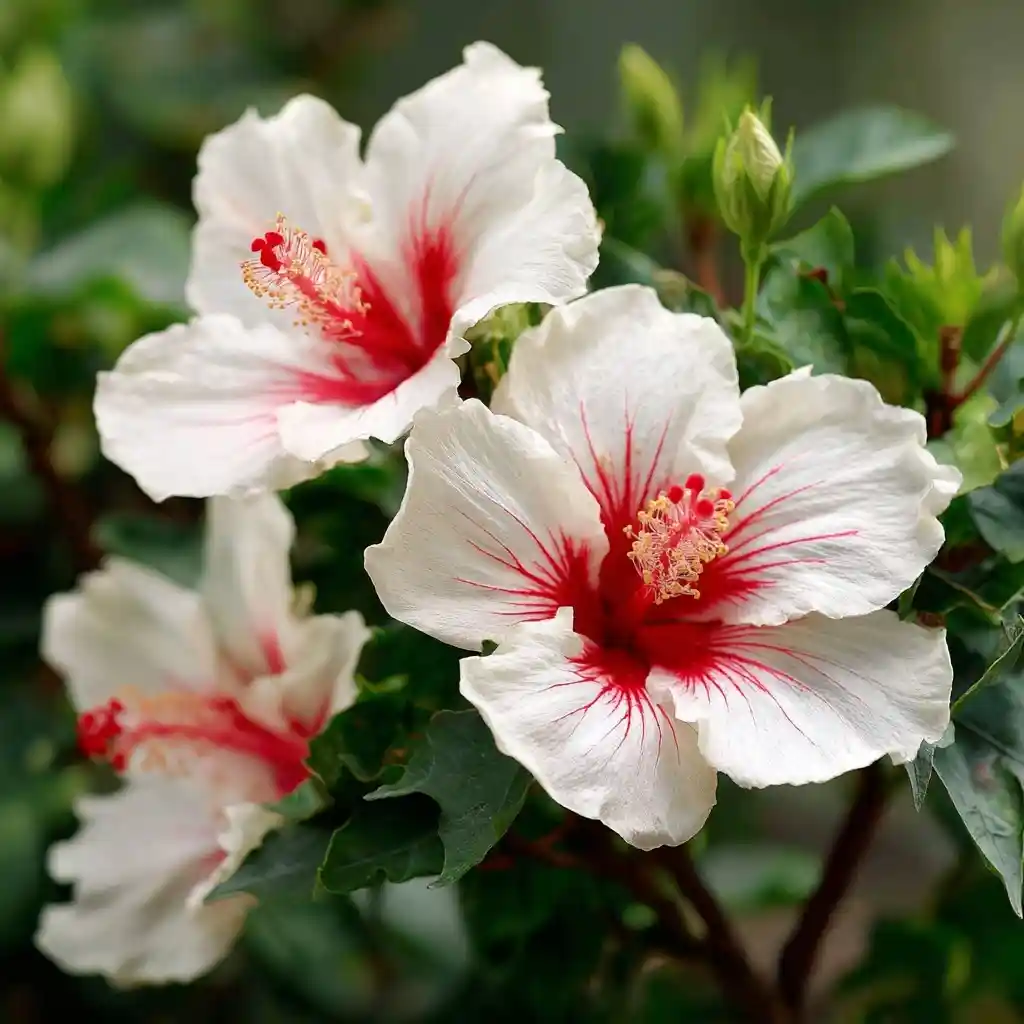
If you’re gardening in a small space or need a compact shrub for a border or container, ‘Lil Kim’ is a perfect fit. This hibiscus flower variety stays petite—reaching just 3 to 4 feet tall—but still delivers large, eye-catching blooms. The white petals are accented by vivid red centers and veining, adding striking contrast to its miniature form.
‘Lil Kim’ is a dwarf cultivar that thrives in both garden beds and pots. It’s a great choice for patios, entryways, or as a low hedge. Despite its size, it blooms prolifically all summer, bringing consistent color without taking over your landscape.
Quick Facts:
- Botanical Name: Hibiscus syriacus ‘Lil Kim’
- Zones: 5–9
- Height: 3–4 ft.
- Light: Full sun to partial shade
- Soil: Moist, well-drained
- Watering: Maintain evenly moist soil for best flowering
🌺 13. Rose of Sharon ‘Lucy’

The ‘Lucy’ hibiscus is a visual feast, known for its full, double blooms in a rich magenta or reddish-fuchsia hue. These large, layered flowers resemble miniature peonies and create a lush, tropical look throughout the summer months. As a hibiscus flower, it adds bold texture and deep color to shrub borders and privacy screens.
‘Lucy’ grows with a naturally bushy habit but can be pruned into a treelike form by removing lower branches in early spring. It’s a sterile cultivar, so there’s no need to manage self-seeding. Give it plenty of sun and regular moisture to keep the blooms coming.
Quick Facts:
- Botanical Name: Hibiscus syriacus ‘Lucy’
- Zones: 5–8
- Height: 6–8 ft.
- Light: Full sun to partial shade
- Soil: Moist, well-drained
- Watering: Deep watering once per week; more often in heat
💗 14. Rose of Sharon ‘Minerva’
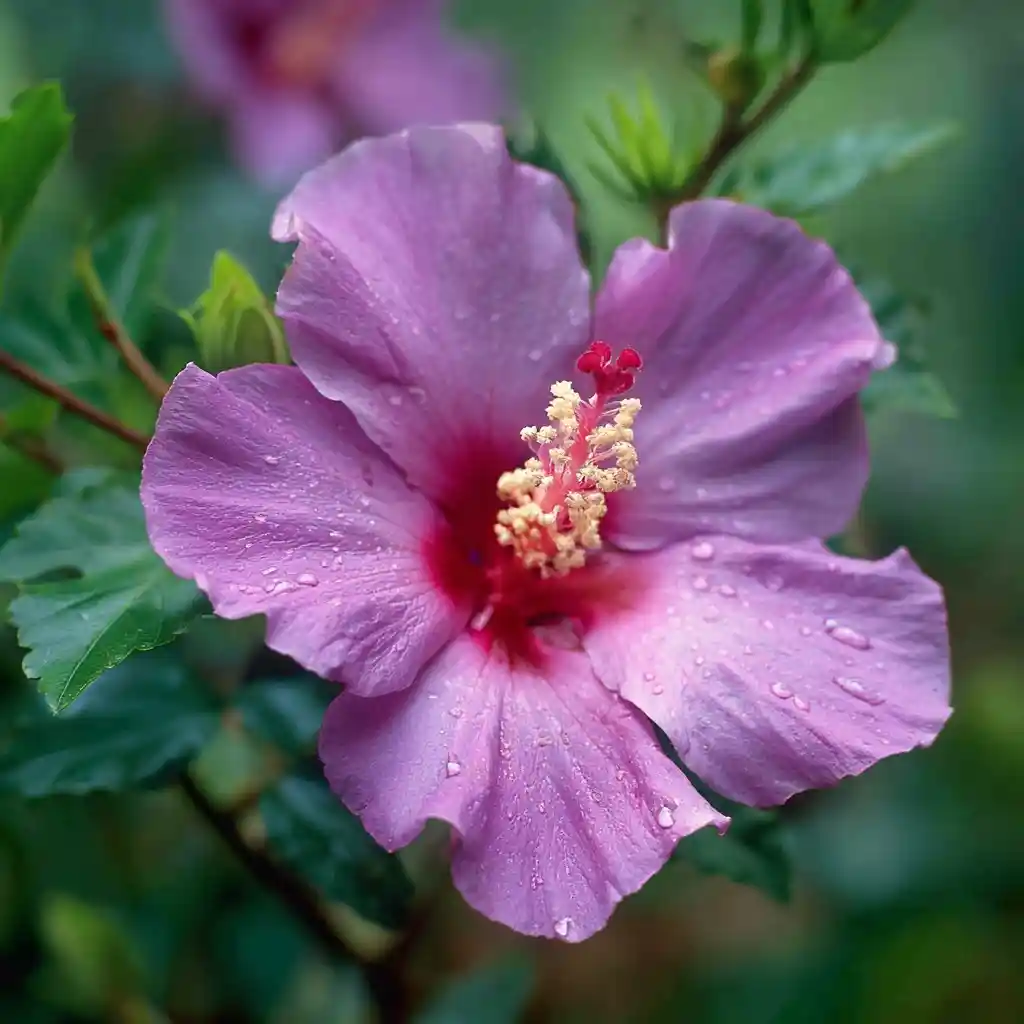
The ‘Minerva’ is a striking hibiscus flower variety known for its lavender-pink petals, deep red throat, and bold, ivory stamens. This long-blooming shrub adds a vibrant splash of color from midsummer into early fall and is especially popular for its durability and low-maintenance needs.
‘Minerva’ is drought-tolerant once established and grows into a tall, upright form, ideal for privacy screens or background plantings. For a fuller shape and larger flowers, prune lightly in late winter or early spring. Its resilience and long bloom time make it a reliable pick for sunny landscapes with well-draining soil.
Quick Facts:
- Botanical Name: Hibiscus syriacus ‘Minerva’
- Zones: 5–8
- Height: Up to 10 ft.
- Light: Full sun to partial shade
- Soil: Loamy, well-drained
- Watering: Keep soil moist; tolerates short dry spells
🟣 15. Rose of Sharon ‘Purple Pillar’
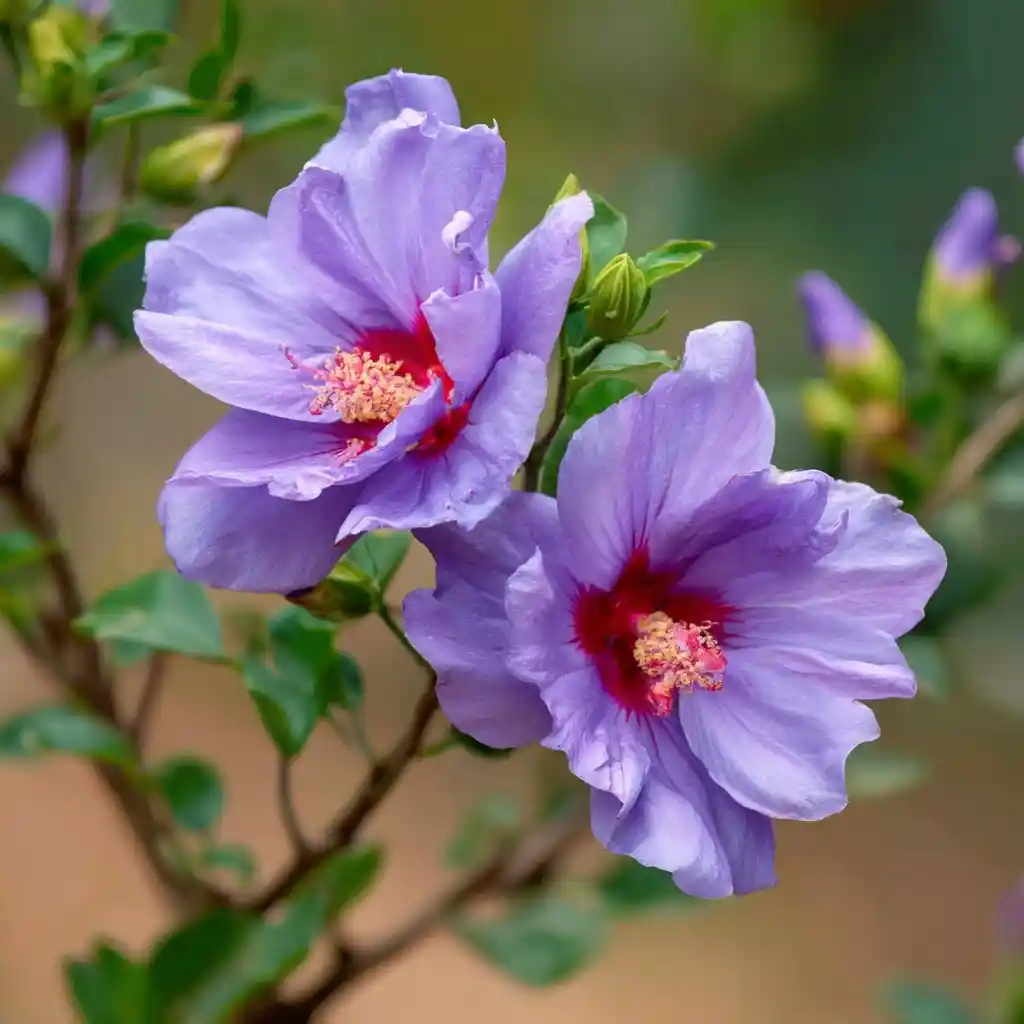
Need vertical interest in a narrow garden space? The ‘Purple Pillar’ is the solution. This hibiscus flower variety grows tall and slim—up to 16 feet high, but only about 3 feet wide—making it perfect for tight borders, entryways, or urban gardens where space is limited.
Its pale purple, semi-double blooms feature deep red throats and bloom continuously from midsummer into fall. ‘Purple Pillar’ is also a favorite for privacy screening where horizontal room is minimal. It adapts well to a range of soils and requires only regular watering to stay vibrant and healthy.
Quick Facts:
- Botanical Name: Hibiscus syriacus ‘Purple Pillar’
- Zones: 5–9
- Height: 10–16 ft.
- Light: Full sun to partial shade
- Soil: Moist, well-drained
- Watering: Keep consistently moist, especially during the first season
💮 16. Rose of Sharon ‘Orchid Satin’
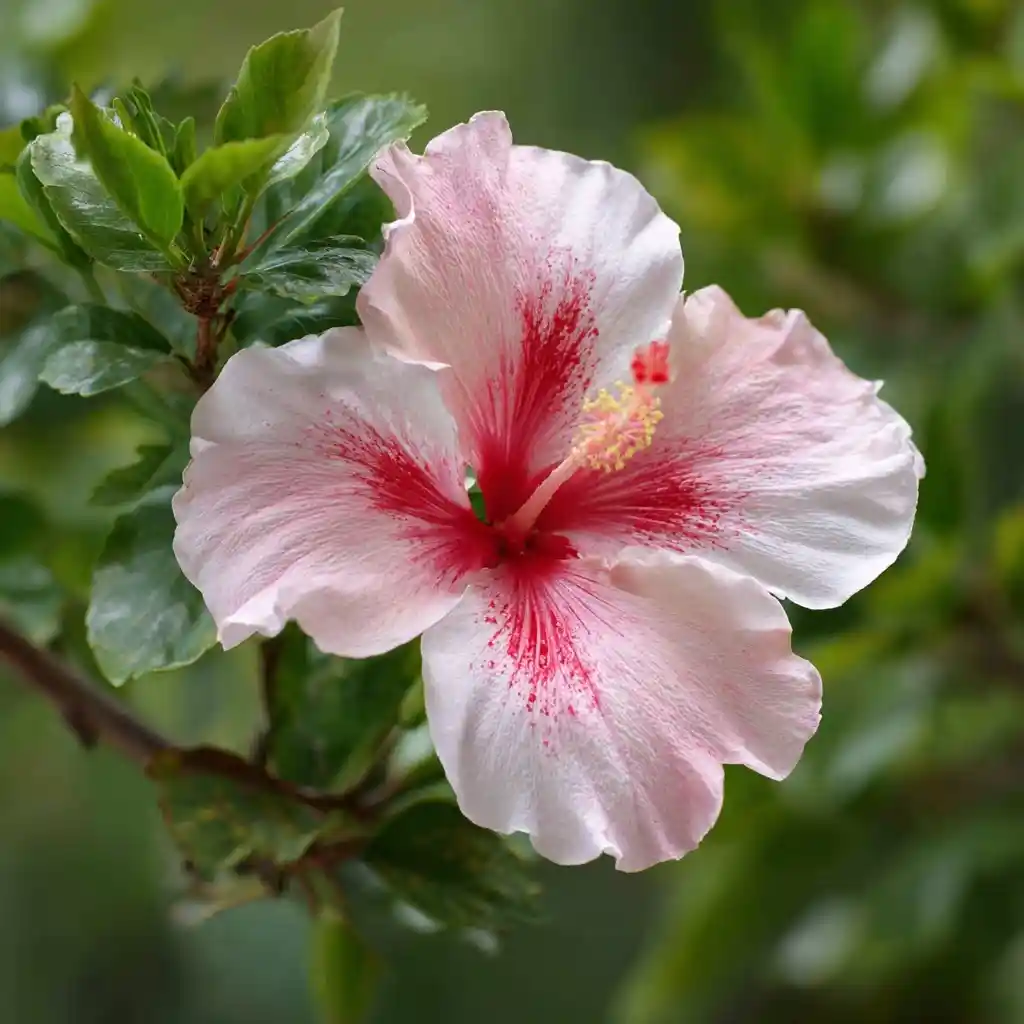
For gardeners who love soft pink tones with a bold center, ‘Orchid Satin’ offers a fresh take on the classic hibiscus flower. Its large, single blooms are pale lavender-pink with a vivid red throat and red veining that radiates outward. The effect is both delicate and dramatic, making it a standout in any summer garden.
This tall, bushy cultivar is sterile, meaning no unwanted spreading, and it grows well as a flowering hedge or privacy screen. It thrives in full sun and well-drained soil, blooming consistently from mid to late summer. It’s also a magnet for pollinators like bees and hummingbirds.
Quick Facts:
- Botanical Name: Hibiscus syriacus ‘Orchid Satin’
- Zones: 5–9
- Height: 8–12 ft.
- Light: Full sun
- Soil: Moist, well-drained
- Watering: Maintain evenly moist soil for best bloom performance
💜 17. Rose of Sharon ‘Purple Satin’
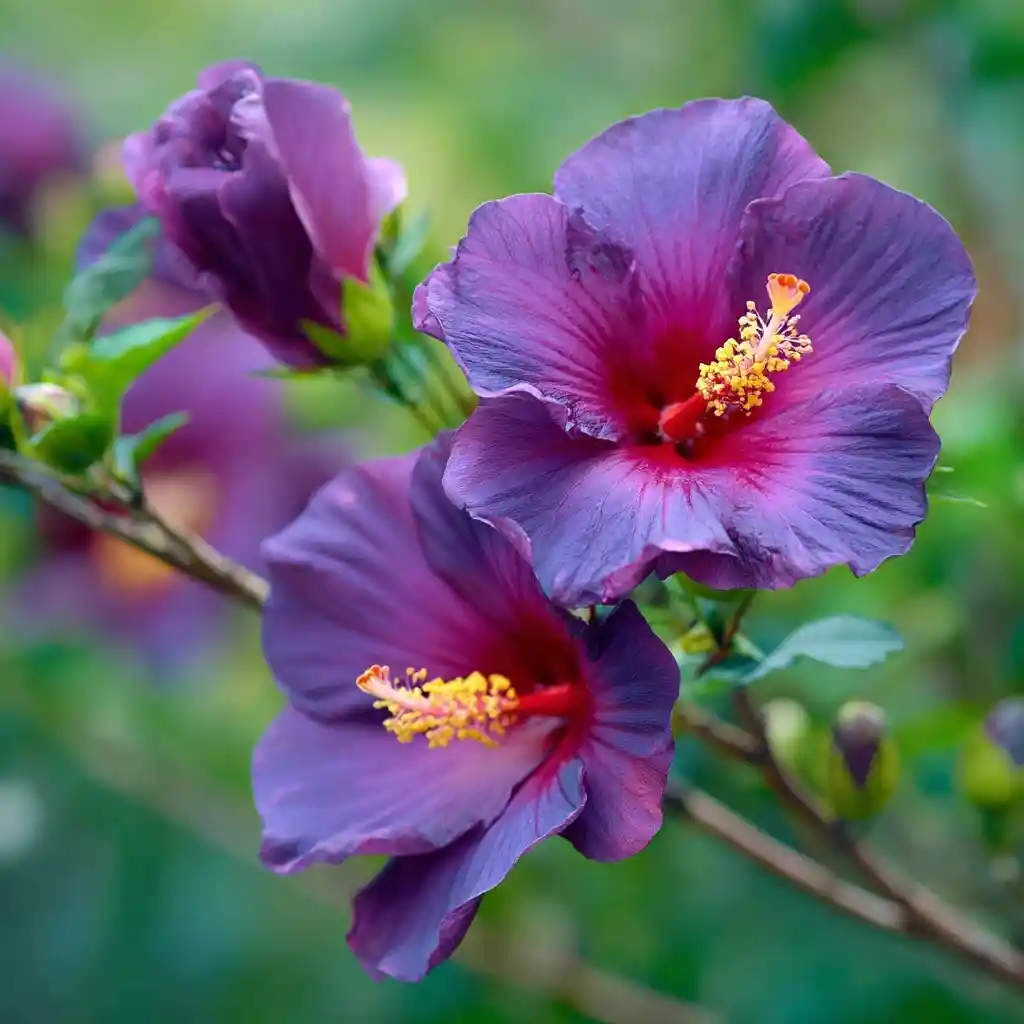
Bold and vibrant, ‘Purple Satin’ brings rich, jewel-toned color to the garden with its deep purple petals and dark red throat. This hibiscus flower variety is known for its long-lasting summer blooms and strong, upright structure, making it an excellent choice for mixed borders or as a colorful privacy hedge.
‘Purple Satin’ is both heat- and drought-tolerant once established, thriving in full sun and well-drained soil. It doesn’t self-seed, so you won’t have to worry about it spreading where it’s not wanted. Give it enough space to reach its full potential, as it grows nearly as wide as it does tall.
Quick Facts:
- Botanical Name: Hibiscus syriacus ‘Purple Satin’
- Zones: 5–9
- Height: 8–12 ft.
- Light: Full sun
- Soil: Rich, well-drained
- Watering: Water when soil starts to dry out
🌿 18. Rose of Sharon ‘Sugar Tip Gold’
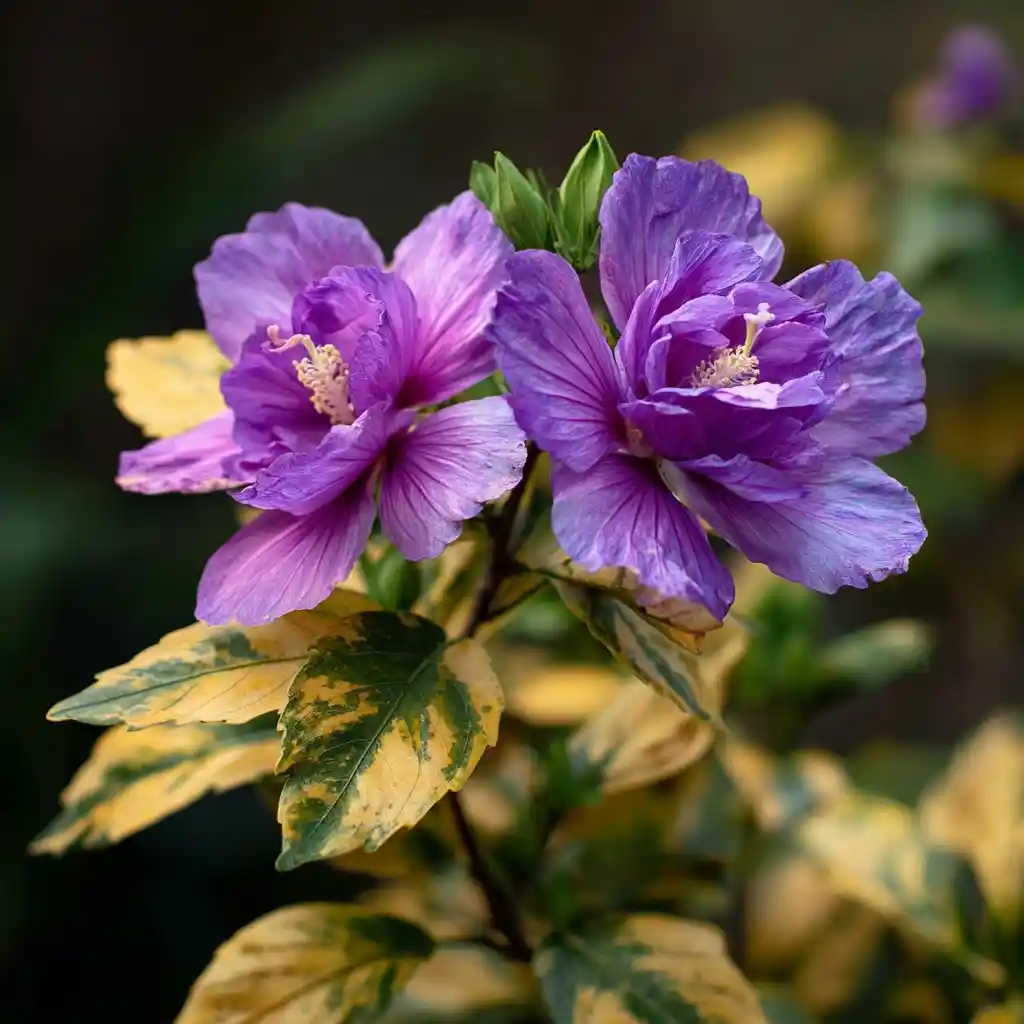
If you’re looking for a hibiscus flower that offers color beyond the blooms, ‘Sugar Tip Gold’ delivers with flair. This compact cultivar features variegated foliage—leaves edged in gold that create visual interest from spring through fall. Its double purple flowers pop dramatically against the golden-green backdrop.
‘Sugar Tip Gold’ is seedless, so you won’t have to manage surprise seedlings. With a modest height of around 4 to 5 feet, it’s perfect for small gardens, patio containers, or low hedges. It performs best in full sun and well-drained soil, blooming steadily from mid to late summer.
Quick Facts:
- Botanical Name: Hibiscus syriacus ‘Sugar Tip Gold’
- Zones: 5–9
- Height: 4–5 ft.
- Light: Full sun
- Soil: Well-drained
- Watering: Keep soil evenly moist for best growth
🌞 19. Tropical Hibiscus
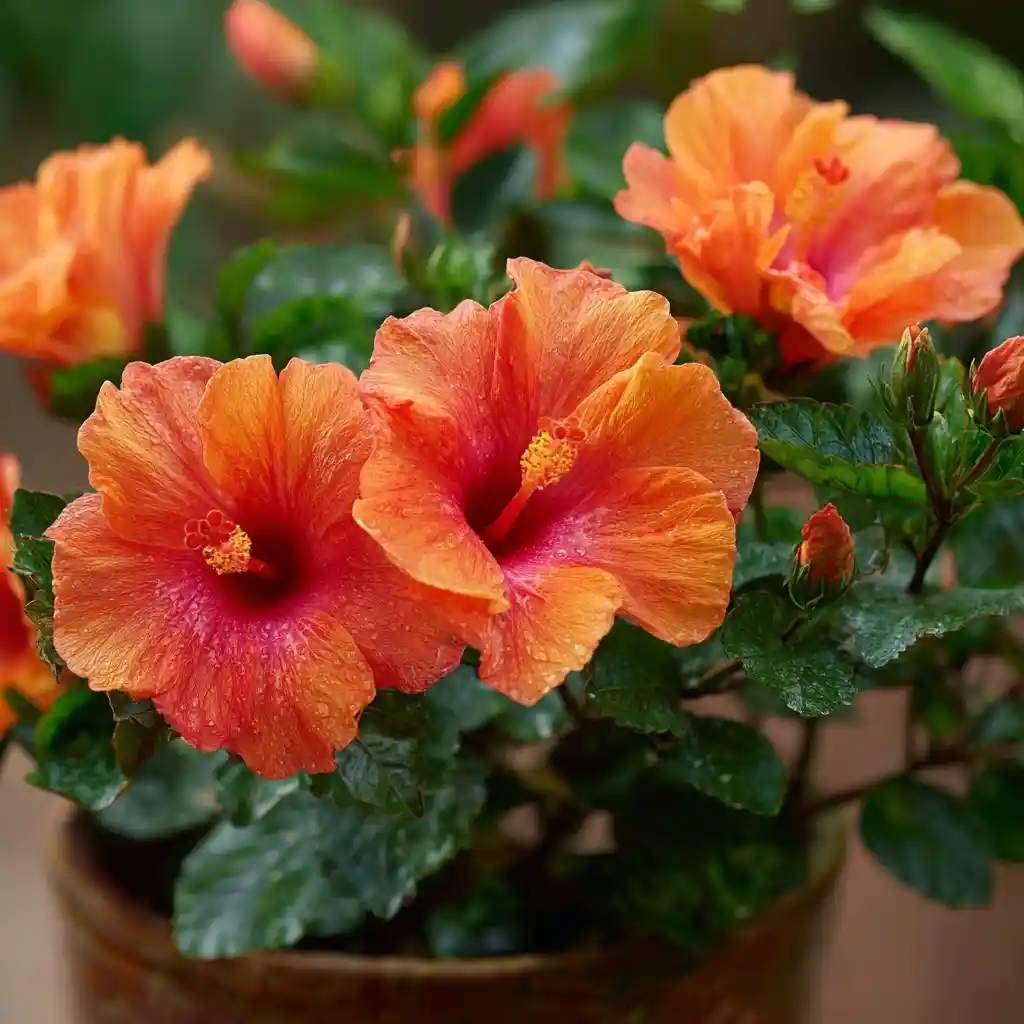
Few plants bring the drama like the tropical hibiscus, known for its enormous, trumpet-shaped blooms in vibrant shades of red, orange, yellow, pink, and even purple. This hibiscus flower variety thrives in warm climates and delivers continuous color from spring through fall.
Best suited for USDA Zones 9–12, tropical hibiscus can be grown as perennials in frost-free regions or enjoyed as annuals or container plants in cooler zones. These lush plants love full sun, regular feeding, and consistently moist soil. Their eye-catching flowers attract hummingbirds and butterflies, making them as lively as they are beautiful.
Quick Facts:
- Botanical Name: Hibiscus rosa-sinensis
- Zones: 9–12
- Height: 4–10 ft.
- Light: Full sun to partial shade
- Soil: Acidic, well-drained
- Watering: Water frequently; keep soil moist but not soggy
🌺 20. Hardy Hibiscus
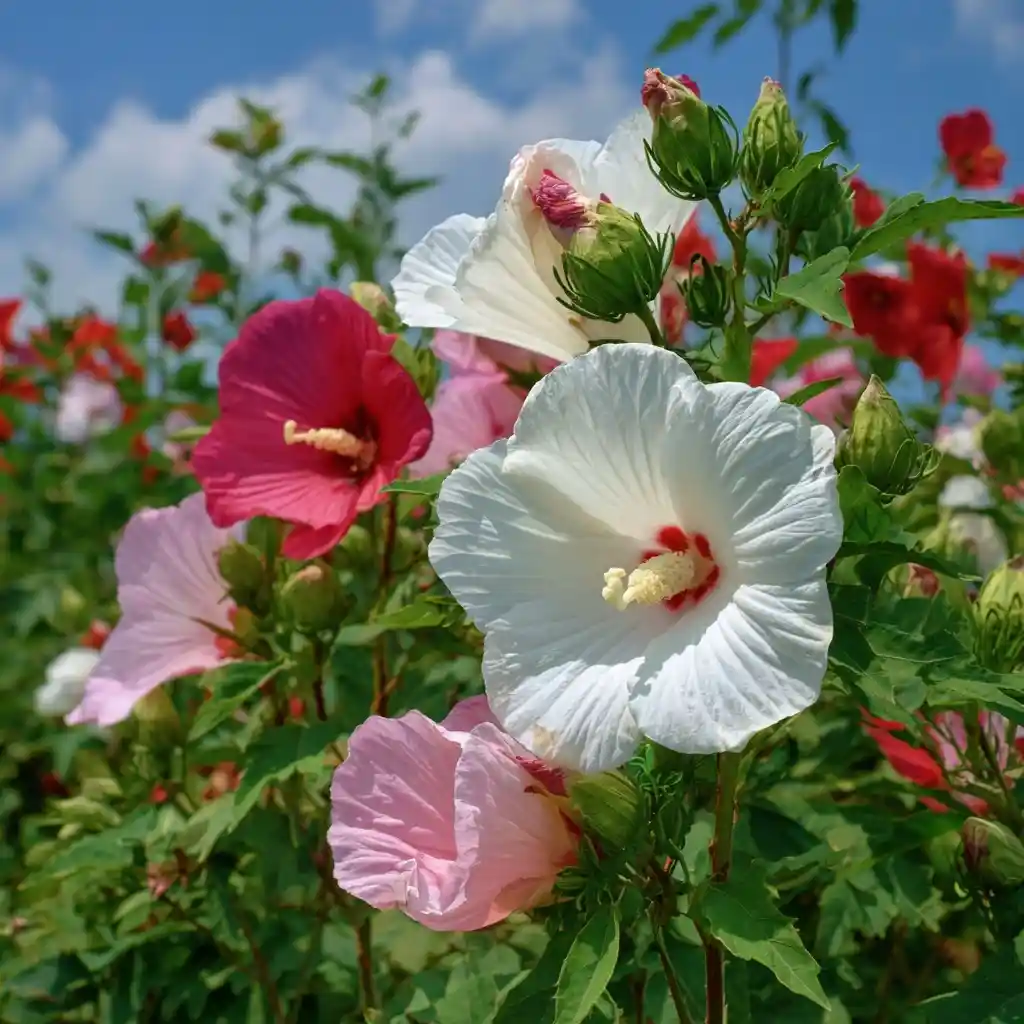
The hardy hibiscus is perfect for gardeners in cooler climates who still want the bold beauty of a tropical-looking bloom. This hibiscus flower features enormous, dinner-plate-sized blossoms in shades of white, red, pink, and even blue. Its flowers may look delicate, but the plant is tough enough to withstand winter temperatures in USDA Zones 4–9.
Hardy hibiscus is a perennial that dies back to the ground in winter and returns with vigor each spring. It prefers consistently moist, nutrient-rich soil and full sun to produce the most abundant blooms. Ideal for borders, rain gardens, or focal points, this variety puts on a spectacular show every summer.
Quick Facts:
- Botanical Name: Hibiscus moscheutos
- Zones: 4–9
- Height: 3–7 ft.
- Light: Full sun
- Soil: Moist, rich, well-drained
- Watering: Deep, regular watering to maintain moisture
🍷 21. Roselle
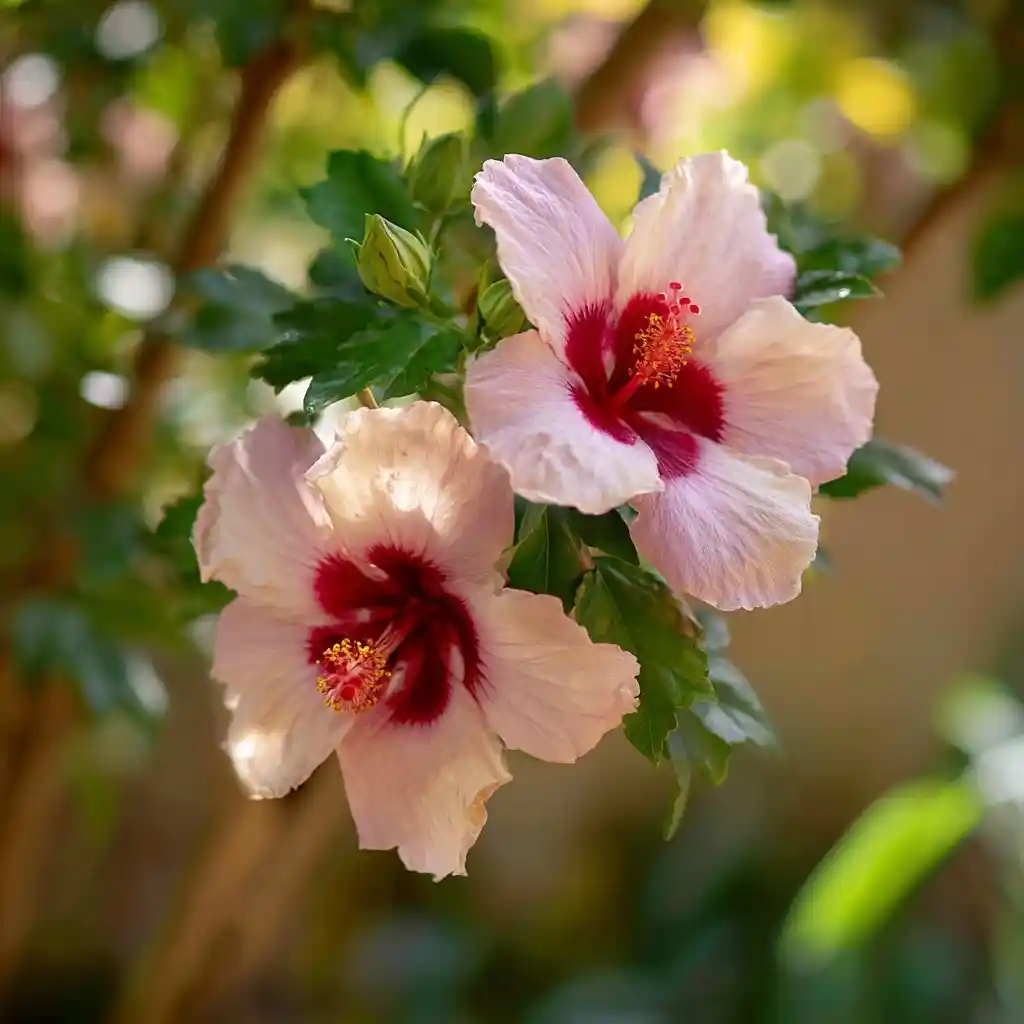
Also known as Florida cranberry, roselle is a unique type of hibiscus flower admired not only for its pale pink blooms with deep red centers but also for its tart, ruby-red calyces. These are often harvested to make herbal teas like hibiscus tea, agua de jamaica, or even jam and syrup.
Roselle grows best in tropical and subtropical climates and loves hot weather with plenty of sunshine. It’s a fast-growing, upright shrub that reaches up to seven feet tall in just one season. In the right conditions, it offers beauty and utility—perfect for edible landscapes or ornamental borders.
Quick Facts:
- Botanical Name: Hibiscus sabdariffa
- Zones: 9–10
- Height: Up to 7 ft.
- Light: Full sun
- Soil: Well-drained
- Watering: Keep soil evenly moist
🌊 22. Sea Hibiscus
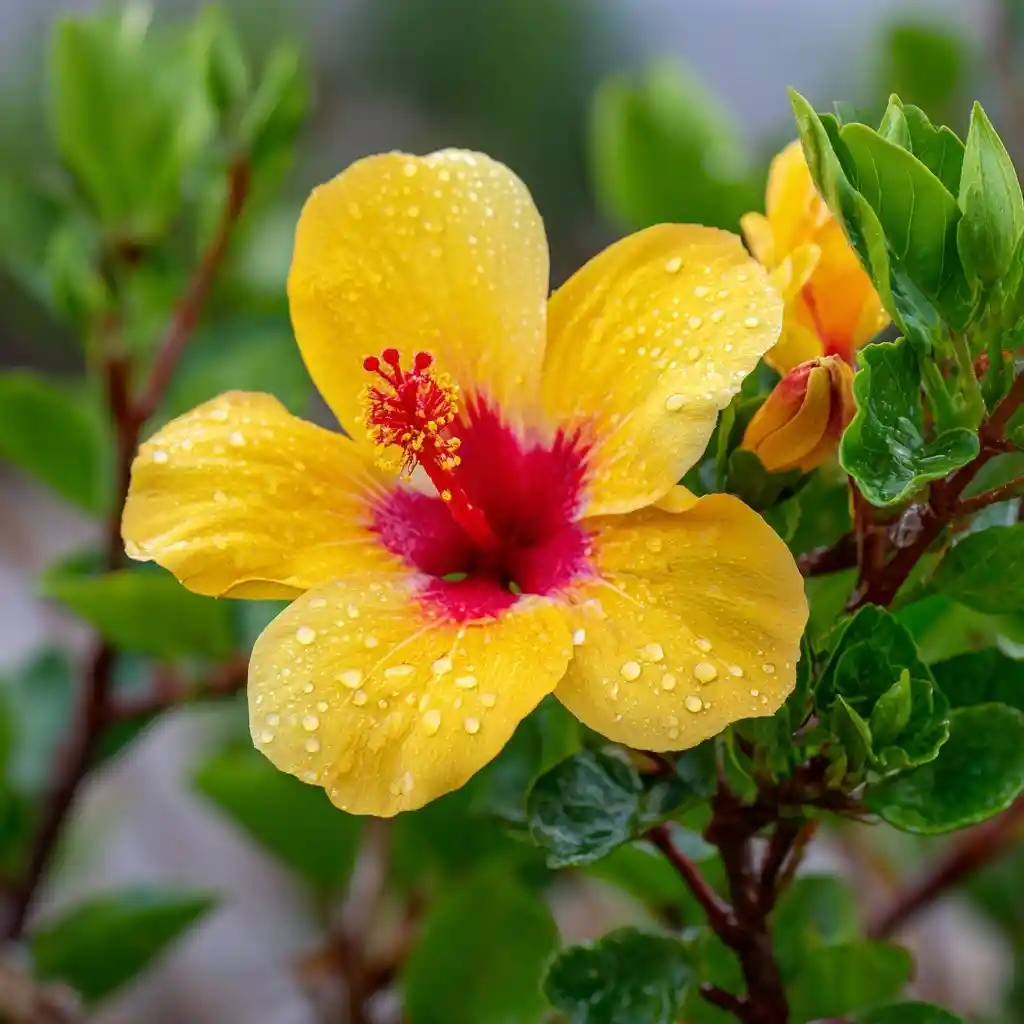
The sea hibiscus, also known as mahoe, brings a coastal vibe to gardens with its bright, lemon-yellow flowers that fade to orange and red within a single day. This color-changing hibiscus flower is ideal for tropical and subtropical landscapes, especially near the coast where salt and wind can challenge less resilient plants.
Native to Asia and now found in warm U.S. zones, sea hibiscus is a fast-growing tree that can reach up to 25 feet tall. Its broad, heart-shaped leaves offer ample shade, making it useful as a windbreak or privacy screen. However, it can become invasive in some coastal areas, so plant with care.
Quick Facts:
- Botanical Name: Hibiscus tiliaceus
- Zones: 10–12
- Height: 12–25 ft.
- Light: Full sun
- Soil: Well-drained
- Watering: Allow soil to dry slightly between waterings
🍁 23. Cranberry Hibiscus

The cranberry hibiscus stands out not for its flowers, but for its bold, burgundy foliage. This ornamental hibiscus flower variety has deep red, maple-like leaves that provide vibrant color from spring through fall—making it a favorite for adding contrast in mixed beds or edible landscapes.
Though its blooms are small and pink, they’re secondary to the plant’s striking foliage. Cranberry hibiscus is often grown as an annual in cooler climates, though it can act as a short-lived perennial in USDA Zones 9–11. The leaves are also edible and mildly tart, often used in salads or teas.
Quick Facts:
- Botanical Name: Hibiscus acetosella
- Zones: 9a–11b
- Height: 3–6 ft.
- Light: Full sun for best color
- Soil: Well-drained
- Watering: Keep soil moist but not soggy
🔴 24. Coral Hibiscus
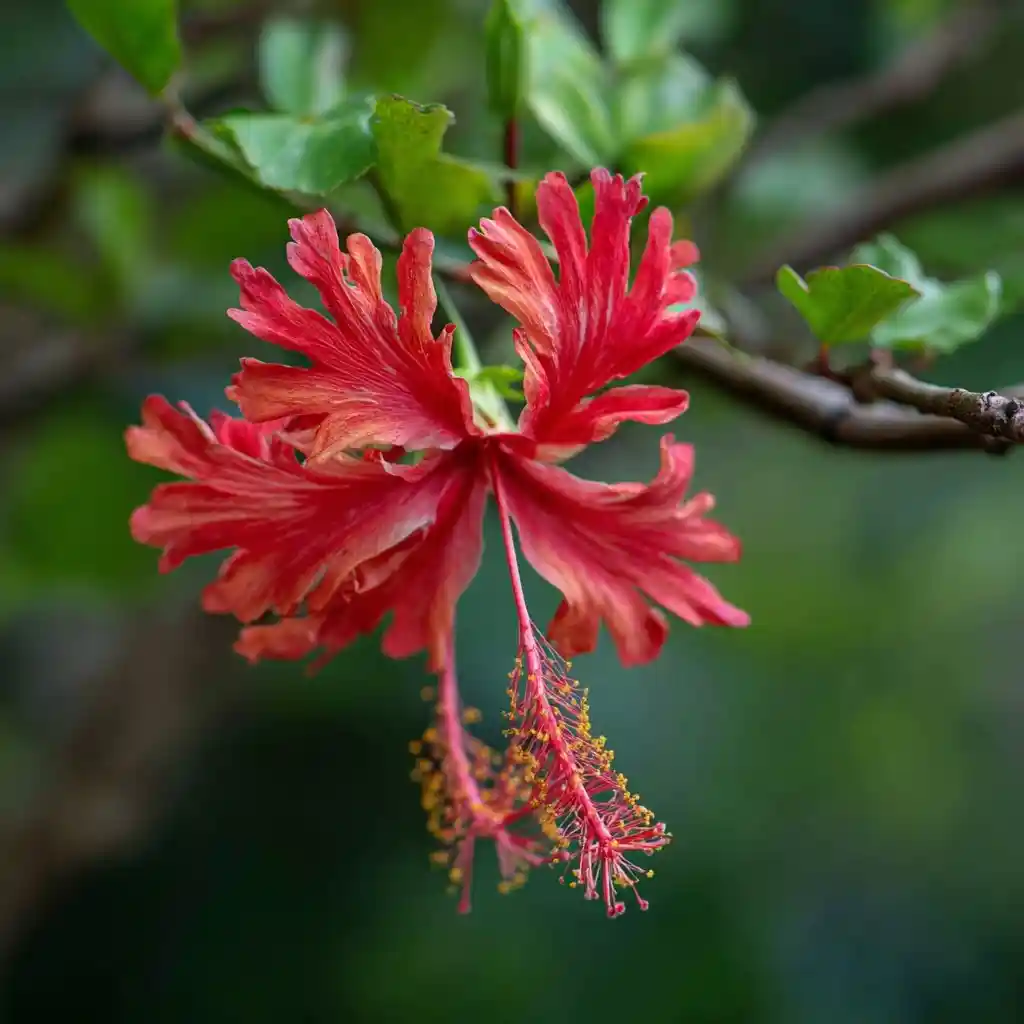
Also known as fringed hibiscus or pagoda flower, the coral hibiscus is one of the most distinctive hibiscus flower types you can grow. Its red, lacy petals curl upward, while the long, exposed stamen dangles below—giving it a chandelier-like appearance that sways beautifully in the breeze.
Unlike more upright hibiscus varieties, this one has a pendulous, tropical look that’s ideal for hanging over walls, trellises, or as a specimen plant in containers. Coral hibiscus thrives in warm climates and prefers consistent moisture and rich soil. It’s a stunning conversation piece that brings elegance and movement to the garden.
Quick Facts:
- Botanical Name: Hibiscus schizopetalus
- Zones: 10–12
- Height: 10–12 ft.
- Light: Full sun
- Soil: Rich, moist, well-drained
- Watering: Keep soil consistently moist, but not soggy
🌸 25. Swamp Rose-Mallow
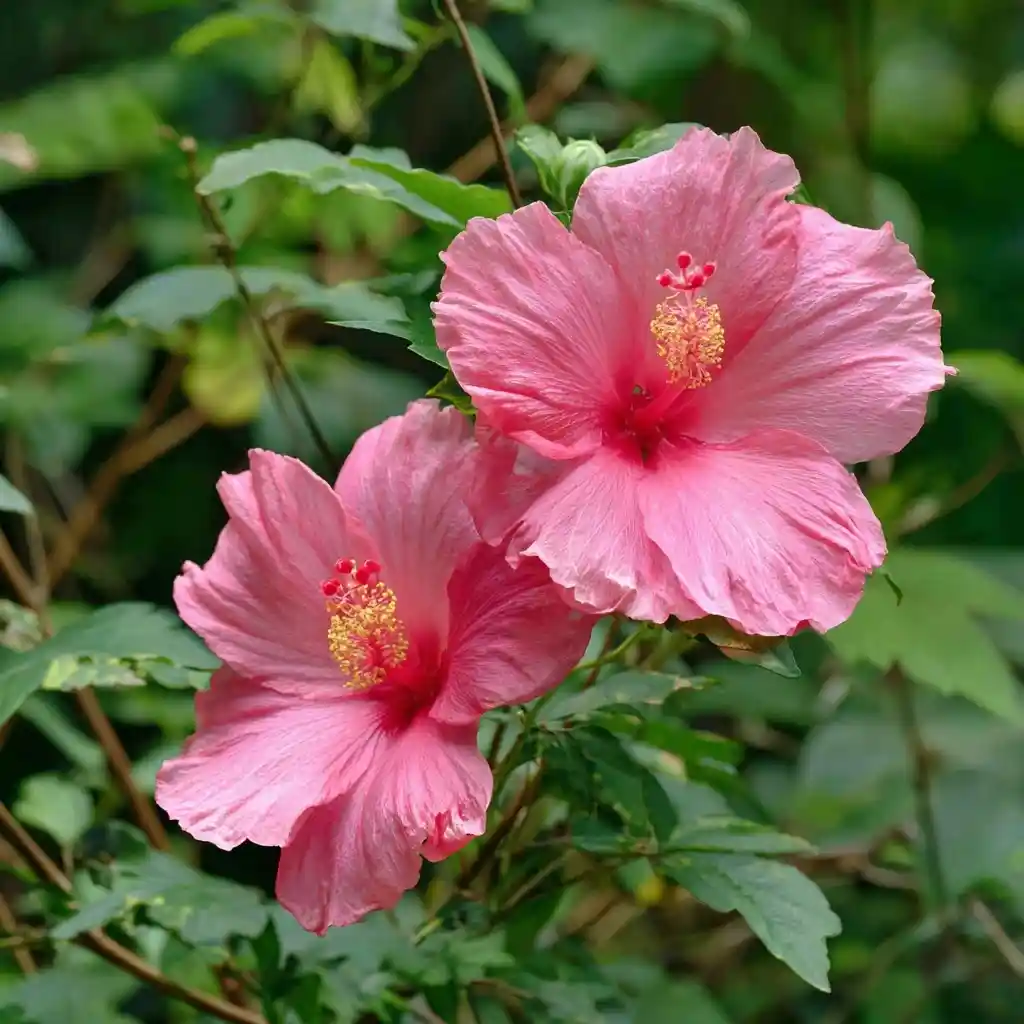
If you’re looking for massive blooms and native charm, the swamp rose-mallow is a top pick. This hibiscus flower variety produces enormous, showy blossoms—often pink or white with red centers—set against velvety, green leaves. Each flower can span up to 10 inches, and the plant may produce dozens of blooms at once during peak season.
Perfect for rain gardens, pond edges, or low-lying spots with poor drainage, this hardy perennial thrives in wet soil and full sun. Native to the southeastern U.S., it brings both visual drama and ecological value to native plant gardens.
Quick Facts:
- Botanical Name: Hibiscus grandiflorus
- Zones: 5–9
- Height: 3–6 ft.
- Light: Full sun to partial shade
- Soil: Acidic or neutral, wet soil preferred
- Watering: Tolerates standing water; soak soil often
🌼 26. Hamabo Hibiscus
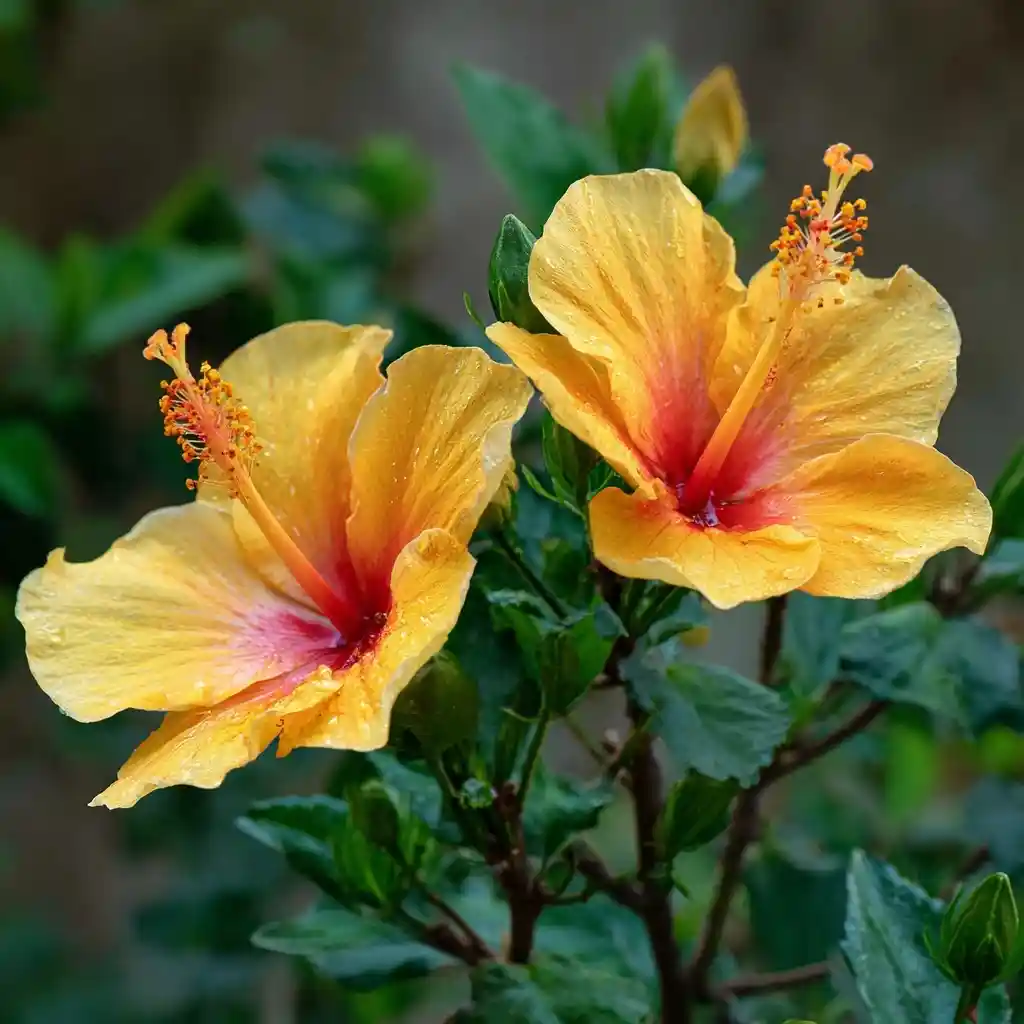
The hamabo hibiscus is a cheerful, pollinator-friendly shrub that bursts with color from late spring through fall. Its soft yellow flowers with reddish centers gradually shift to orange as they age—creating a multicolored effect that adds dynamic interest to any garden. This hibiscus flower is especially attractive to hummingbirds and butterflies.
Native to East Asia and well-suited to warm coastal climates, hamabo hibiscus is ideal for hedging or as a standalone accent. It’s adaptable to full sun or partial shade and grows in a wide range of well-drained soils. Its resilience and bloom power make it a low-fuss favorite.
Quick Facts:
- Botanical Name: Hibiscus tiliaceus (Hamabo)
- Zones: 8–12
- Height: 6–15 ft.
- Light: Full sun to partial shade
- Soil: Moist, well-drained
- Watering: Keep soil evenly moist, avoid letting it dry out
⚔️ 27. Halberd-Leaf Rosemallow
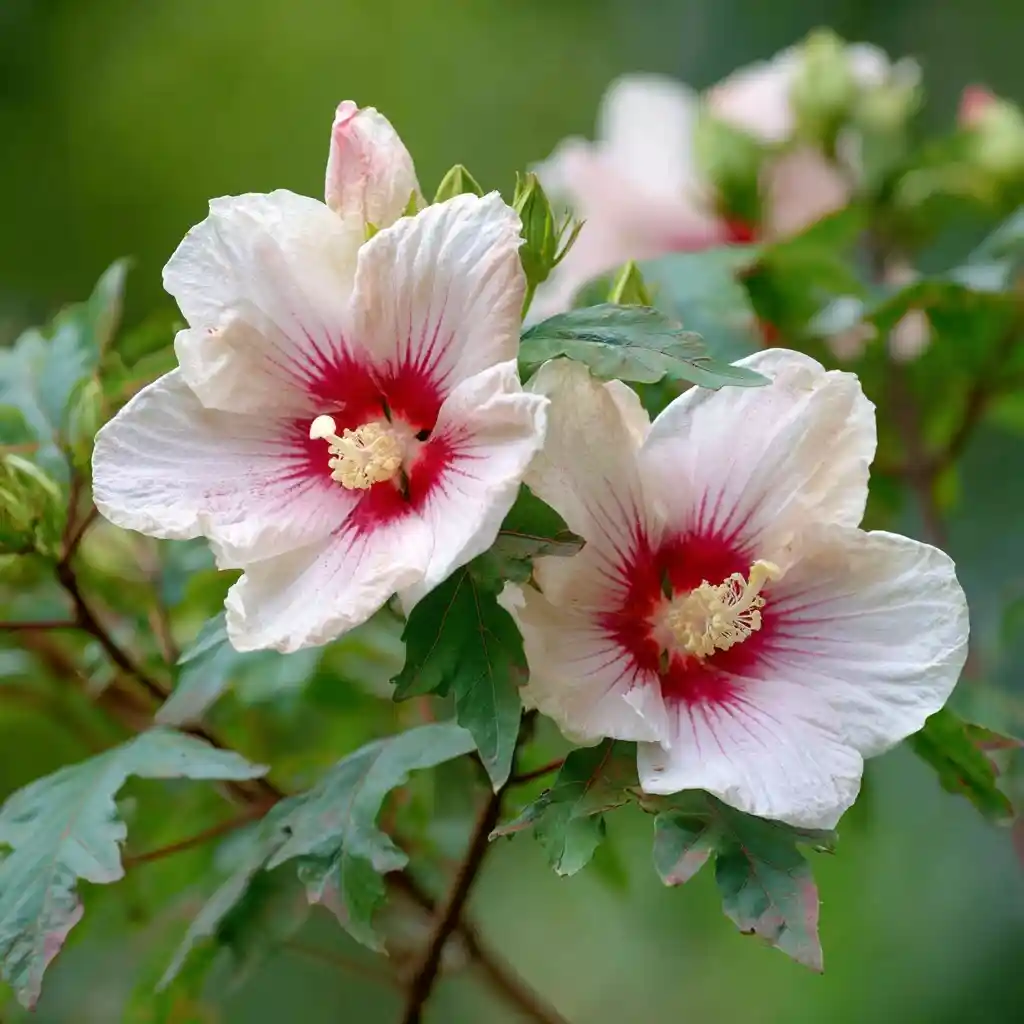
Named for the shape of its leaves—resembling a medieval halberd spear—the halberd-leaf rosemallow is a native hibiscus flower that thrives in wetland and marshy areas. Its large, delicate, cup-shaped blooms come in shades of creamy white or pink with rich red centers, blooming steadily throughout summer.
This fast-growing perennial is an excellent choice for rain gardens or soggy spots where other plants may struggle. Its upright stems support abundant blooms, and its native range across the Midwest and East Coast makes it a top pick for eco-conscious gardeners focused on supporting local biodiversity.
Quick Facts:
- Botanical Name: Hibiscus laevis
- Zones: 4–9
- Height: Up to 6 ft.
- Light: Partial sun
- Soil: Moist, sandy loam
- Watering: High water needs; thrives in wet soil
🤍🌴 28. Hawaiian White Hibiscus
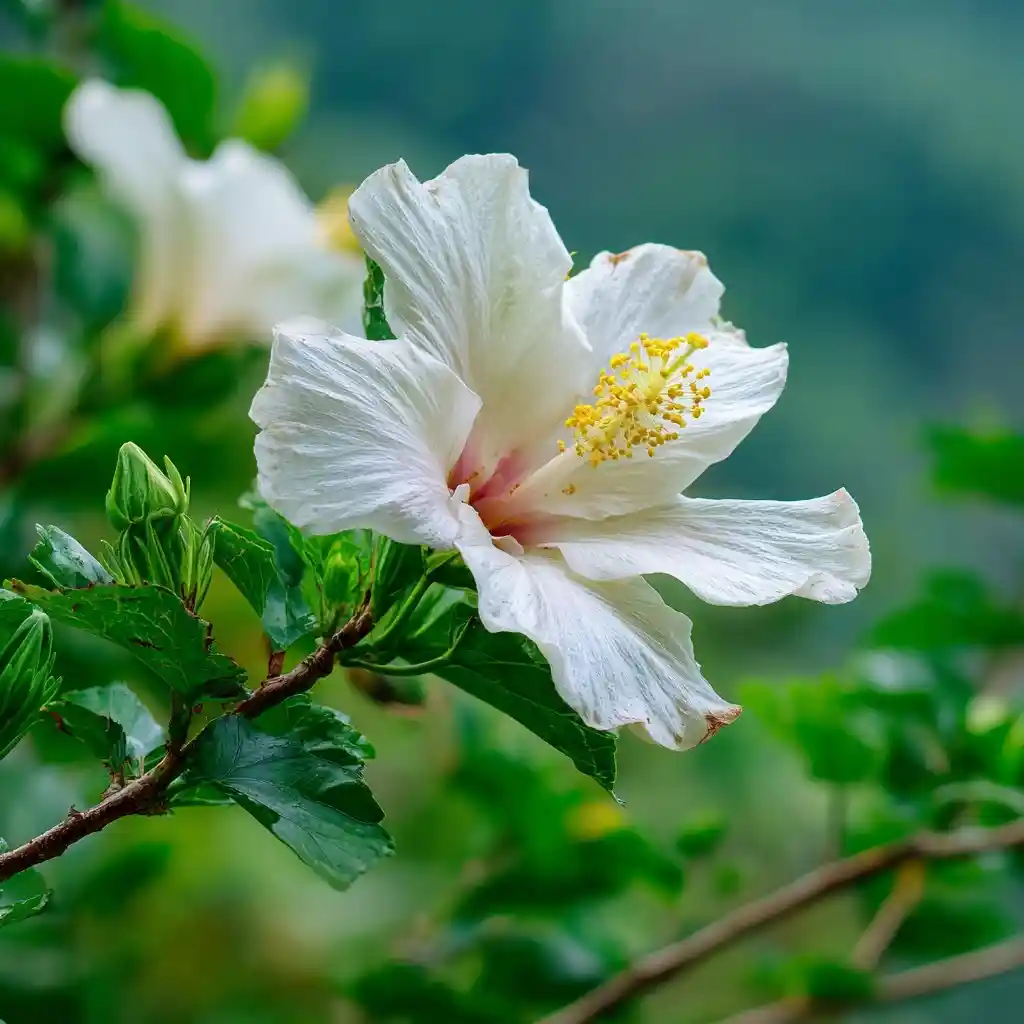
Rare and naturally found only in the Hawaiian Islands, the Hawaiian white hibiscus is a fragrant gem among hibiscus flower varieties. Unlike most hibiscus species, this one releases a mild, pleasant scent, making it a prized addition to tropical and subtropical gardens.
Its large, white flowers are crisp and clean, offering a classic look that stands out against the plant’s deep green foliage. This evergreen shrub grows best in full sun and well-drained soil. In ideal conditions, it blooms nearly year-round, attracting both pollinators and admiring glances from passersby.
Quick Facts:
- Botanical Name: Hibiscus arnottianus
- Zones: 9–11
- Height: 7–10 ft.
- Light: Full sun to partial shade
- Soil: Well-drained
- Watering: Keep soil evenly moist; don’t let it dry out completely
🌳 29. Woody Rose-Mallow
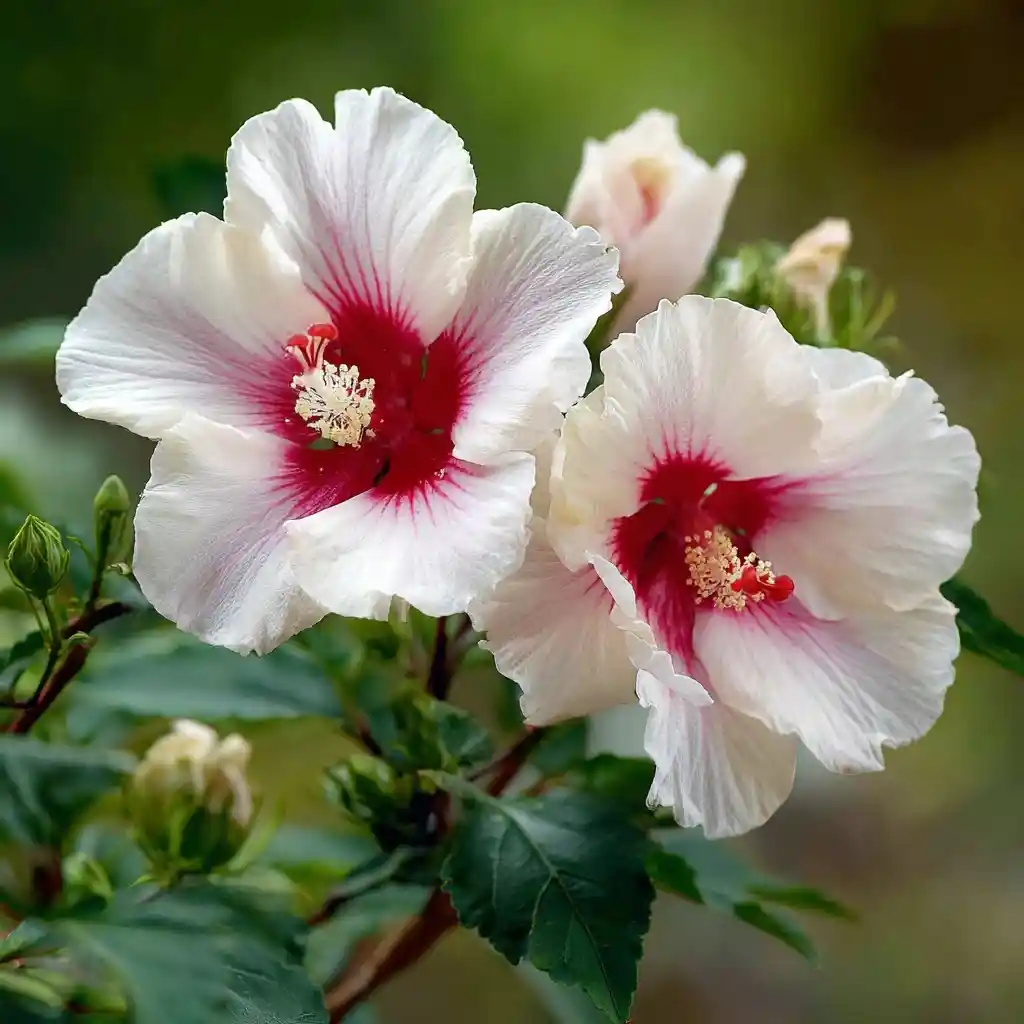
Also known as false cotton, the woody rose-mallow is a native hibiscus flower species that delivers oversized, eye-catching blooms in shades of white or pale pink with deep red centers. These flowers appear from late spring through early fall and are set against fuzzy green foliage that adds to the plant’s textural appeal.
Hardy and adaptable, woody rose-mallow is well-suited for hot, humid environments and thrives in consistently moist soil. It’s a great choice for planting along ponds, in wetland edges, or as part of a native garden. Its upright habit and dramatic flowers make it both functional and ornamental.
Quick Facts:
- Botanical Name: Hibiscus lasiocarpos
- Zones: 5–9
- Height: Up to 8 ft.
- Light: Full sun to partial shade
- Soil: Well-drained, moist
- Watering: Keep soil evenly moist; avoid drying out
😴🌸 30. Sleepy Hibiscus
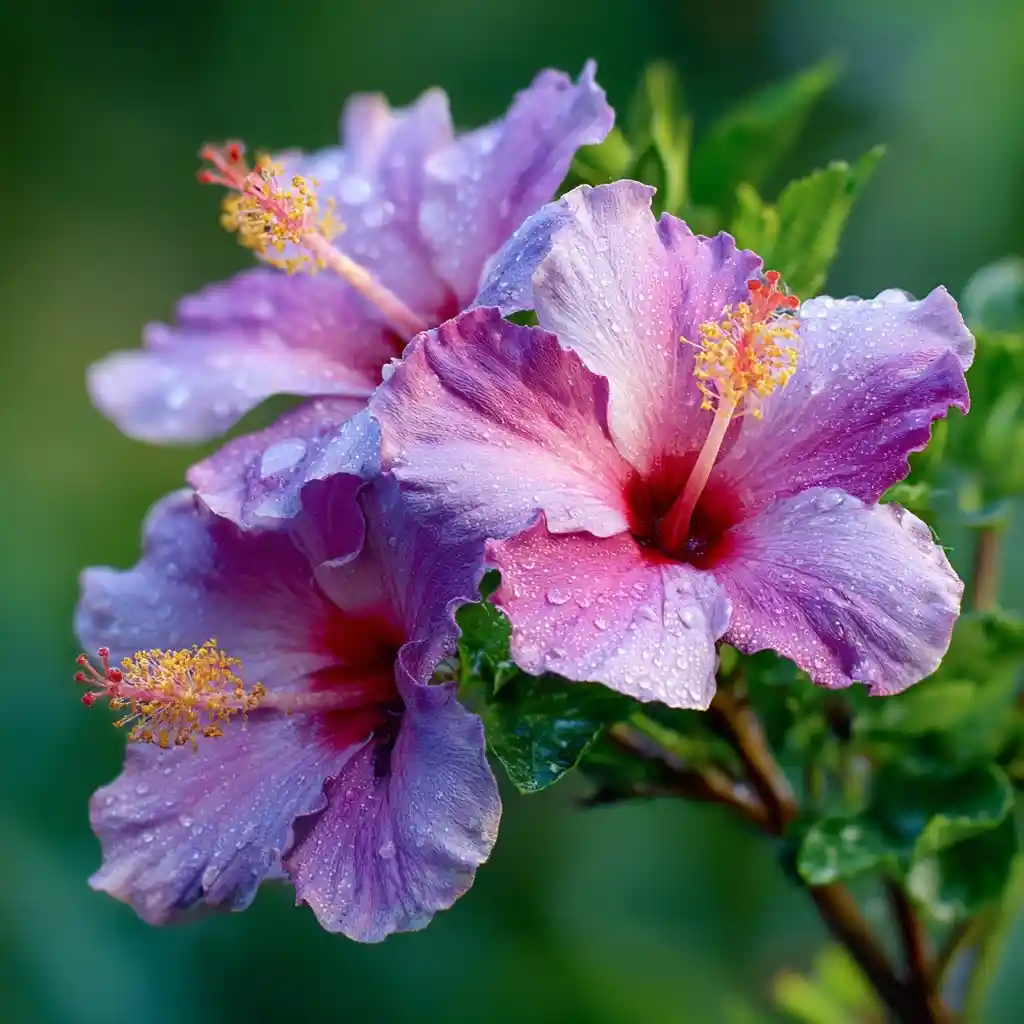
The sleepy hibiscus gets its name from the way its delicate, cupped flowers seem to droop as if nodding off. These unique hibiscus flowers come in shades of pink and purple, accented by bright pink stamens and vivid red centers. Their slightly closed appearance gives them a soft, relaxed charm that stands out among more open-blooming varieties.
A hardy perennial in zones 5 through 9, sleepy hibiscus is well-suited to warm regions and thrives in full sun. It prefers loamy or sandy soil and appreciates consistently moist conditions—especially during hot, dry spells. This low-maintenance plant is perfect for naturalized borders or pollinator gardens.
Quick Facts:
- Botanical Name: Hibiscus furcellatus
- Zones: 5–9
- Height: 6–8 ft.
- Light: Full sun
- Soil: Loam or sand, moist
- Watering: Water frequently to keep soil consistently moist
🪨🌺 31. Rock Hibiscus
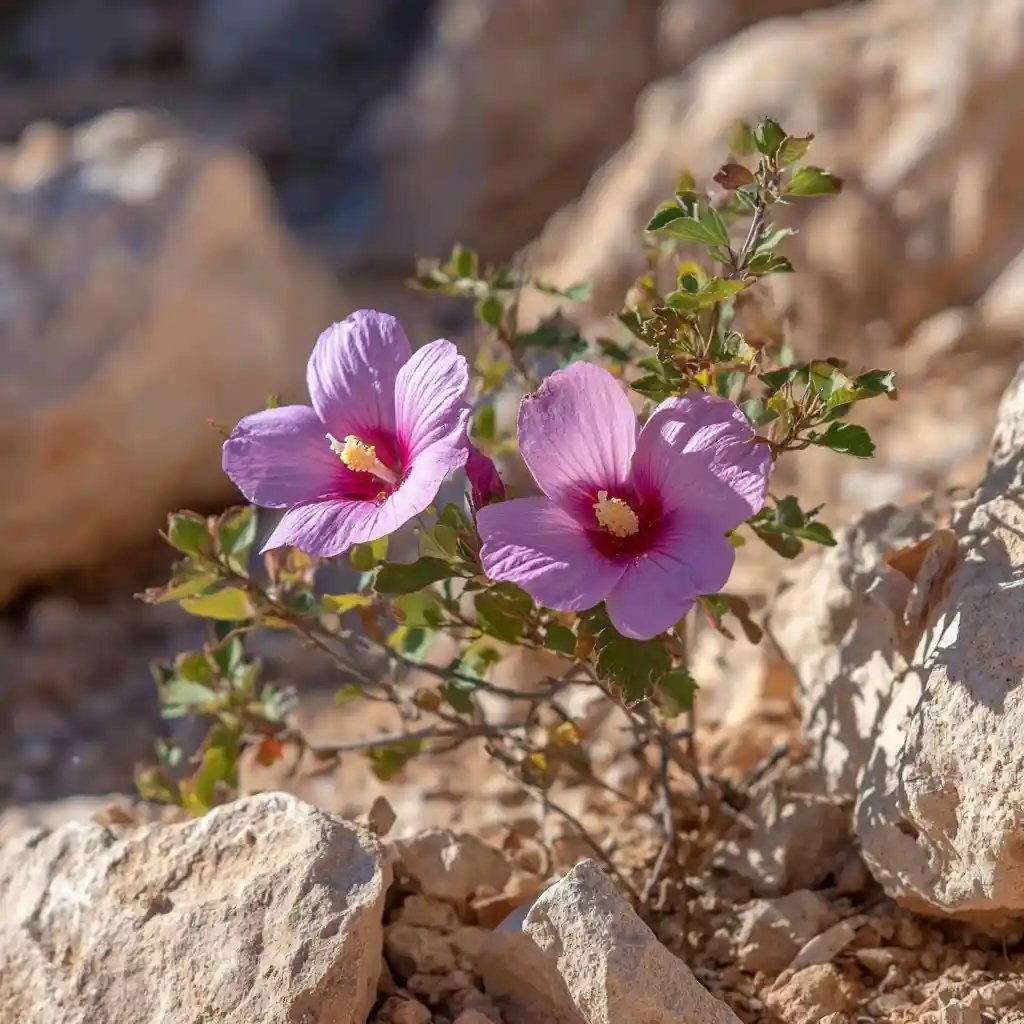
Perfect for arid landscapes, the rock hibiscus is a drought-tolerant hibiscus flower native to the rocky hillsides of the Southwestern U.S. and northern Mexico. Unlike its lush tropical cousins, this species stays compact and rugged, with sparse foliage and small, delicate blooms in soft pink or lavender.
Despite its modest size, rock hibiscus produces flowers almost year-round in warm climates, especially when given occasional deep watering. It thrives in rocky, sandy, and even alkaline soils, making it ideal for xeriscaping, desert gardens, or as an accent in cactus beds.
Quick Facts:
- Botanical Name: Hibiscus denudatus
- Zones: 7a and warmer
- Height: 1–3 ft.
- Light: Partial to full sun
- Soil: Well-drained, rocky or sandy
- Watering: Minimal; water only during extended dry periods
🌺🌺 32. Double Hibiscus
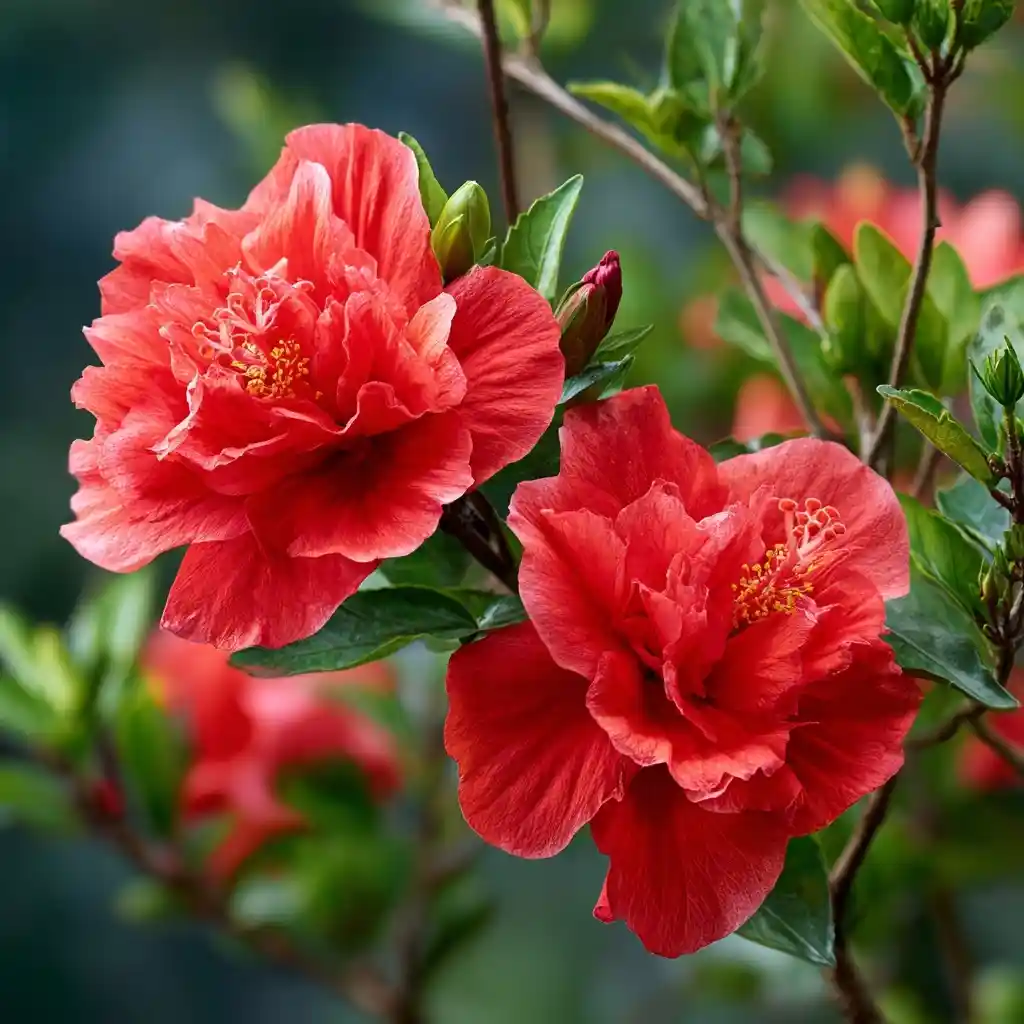
If you’re drawn to dramatic, full-petaled blooms, the double hibiscus is a must-have. This hibiscus flower variety features lush, ruffled blossoms that look more like peonies than typical hibiscus, often in bold shades of red, pink, yellow, orange, or white. The double layers add volume and flair, making it a garden showstopper.
Perfect for tropical and subtropical regions, double hibiscus grows well as a hedge, accent plant, or in containers. Regular pruning keeps it full and manageable, especially after the blooming season. In cooler zones, it can be overwintered indoors or grown as a seasonal patio plant.
Quick Facts:
- Botanical Name: Hibiscus rosa-sinensis (Double forms)
- Zones: 9–11
- Height: 6–10 ft.
- Light: Full sun
- Soil: Well-drained
- Watering: Keep soil evenly moist, especially during bloom season
🐉🌺 33. Hibiscus ‘Black Dragon’
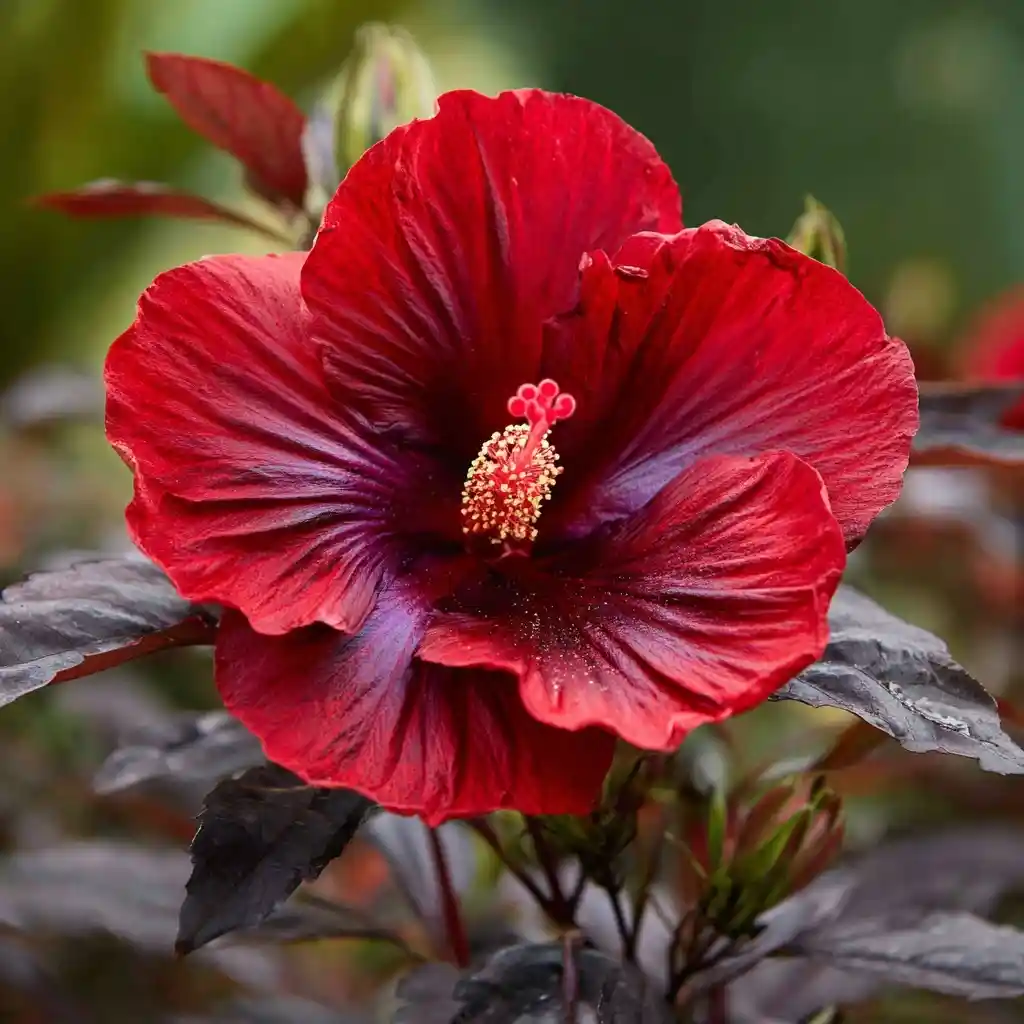
A true statement plant, ‘Black Dragon’ is a tropical hibiscus flower variety with huge, eight-inch blooms in deep crimson with nearly black centers. The moody, velvety petals create a gothic, high-drama effect that’s perfect for bold garden designs or tropical-themed containers.
This award-winning cultivar grows slowly at first but becomes fuller and bushier over time. It performs best in full sun with well-drained soil and regular moisture. In colder climates, ‘Black Dragon’ can be grown in pots and overwintered indoors. Its rare color combination makes it a standout among hibiscus enthusiasts.
Quick Facts:
- Botanical Name: Hibiscus rosa-sinensis ‘Black Dragon’
- Zones: 9–11
- Height: 3–6 ft.
- Light: Full sun
- Soil: Well-drained
- Watering: Keep soil consistently moist; avoid waterlogging
🌞🌈 34. Hibiscus ‘Fiesta Del Sol’
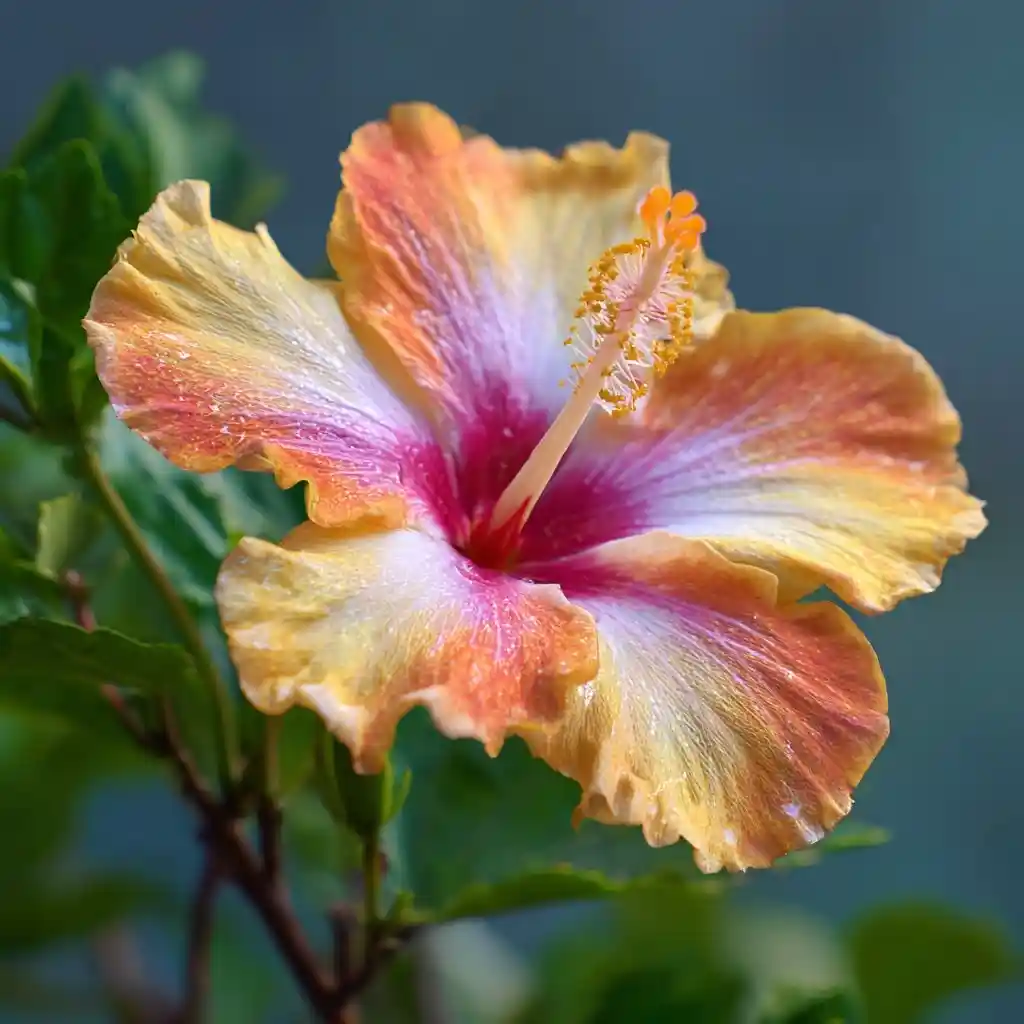
‘Fiesta Del Sol’ lives up to its festive name with show-stopping, multicolored blooms that shift color throughout the day. The large hibiscus flowers open in a fiery orange hue each morning and gradually fade to bright yellow by evening. A deep burgundy center adds striking contrast, ringed by flashes of pink and white.
This tropical hibiscus thrives in hot climates and demands full sun to bring out its boldest colors. Ideal for large containers or sunny borders, it needs consistently moist, well-drained soil and regular feeding during the growing season. Its vibrant palette makes it a perfect centerpiece for summer displays.
Quick Facts:
- Botanical Name: Hibiscus rosa-sinensis ‘Fiesta Del Sol’
- Zones: 10–11
- Height: 2–4 ft.
- Light: Full sun
- Soil: Well-drained
- Watering: Keep soil moist and never let it fully dry out
🌌🌸 35. Hibiscus ‘Midnight Tryst’
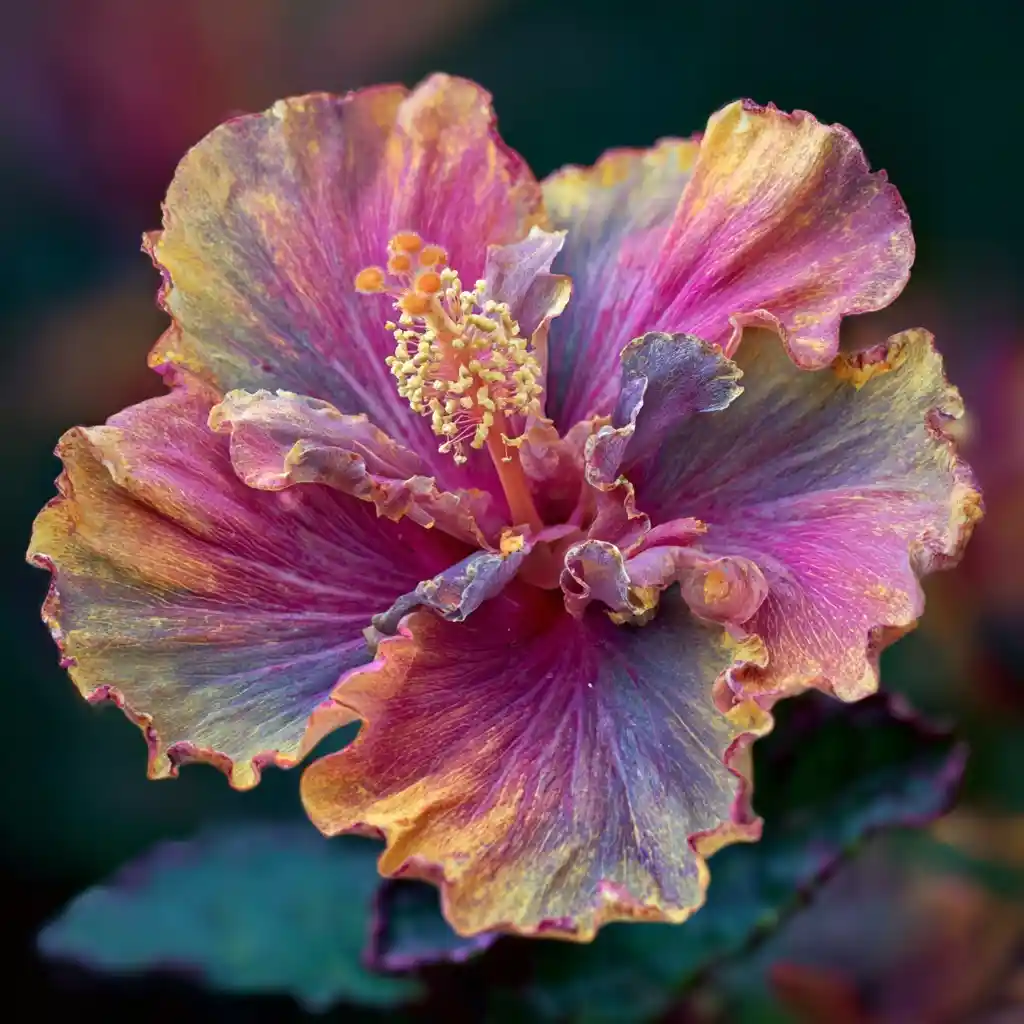
‘Midnight Tryst’ is a kaleidoscope of color wrapped into a single hibiscus flower. Its massive blooms feature soft pink edges that blend into smoky purple-gray petals, accented by white veining and a fiery red center. Though each bloom lasts just a day or two, the dramatic display is well worth it.
This tropical hibiscus hybrid thrives in full sun and requires consistently moist, rich soil. It’s ideal for warm zones or as a container showpiece in cooler areas. With the right care, ‘Midnight Tryst’ delivers a parade of vivid blooms throughout the growing season, adding instant wow factor to patios or garden beds.
Quick Facts:
- Botanical Name: Hibiscus rosa-sinensis ‘Midnight Tryst’
- Zones: 10–11
- Height: 2–4 ft.
- Light: Full sun
- Soil: Rich, well-drained
- Watering: Keep soil evenly moist; avoid letting it dry out
🌅🌺 36. Hibiscus ‘The Path’
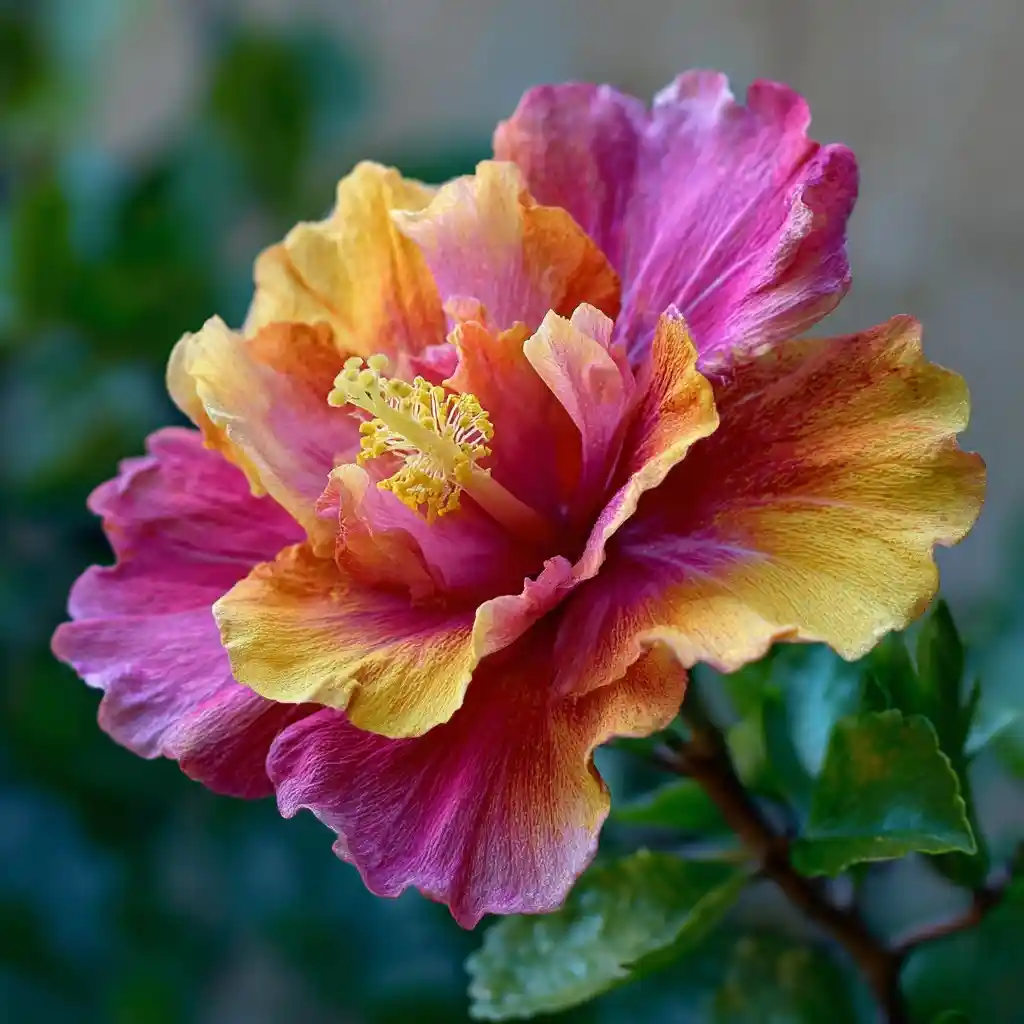
Color-shifting and eye-catching, ‘The Path’ is a tropical hibiscus flower variety that creates a glowing ombré effect on each petal. Its blooms begin in sunny yellow at the edges and gradually deepen to rich orange and rose tones near the center. The dramatic gradient makes it a popular pick for gardeners who love dynamic color.
This compact shrub performs best in warm climates with full sun and fertile, well-drained soil. ‘The Path’ blooms prolifically with regular watering and light feeding during the growing season. It’s ideal for tropical borders, patio pots, or as an accent plant in vibrant summer gardens.
Quick Facts:
- Botanical Name: Hibiscus rosa-sinensis ‘The Path’
- Zones: 10+
- Height: 2–4 ft.
- Light: Full sun
- Soil: Moist, well-drained
- Watering: Keep soil evenly moist but never soggy
🔮🌼 37. Hibiscus ‘Voodoo Queen’
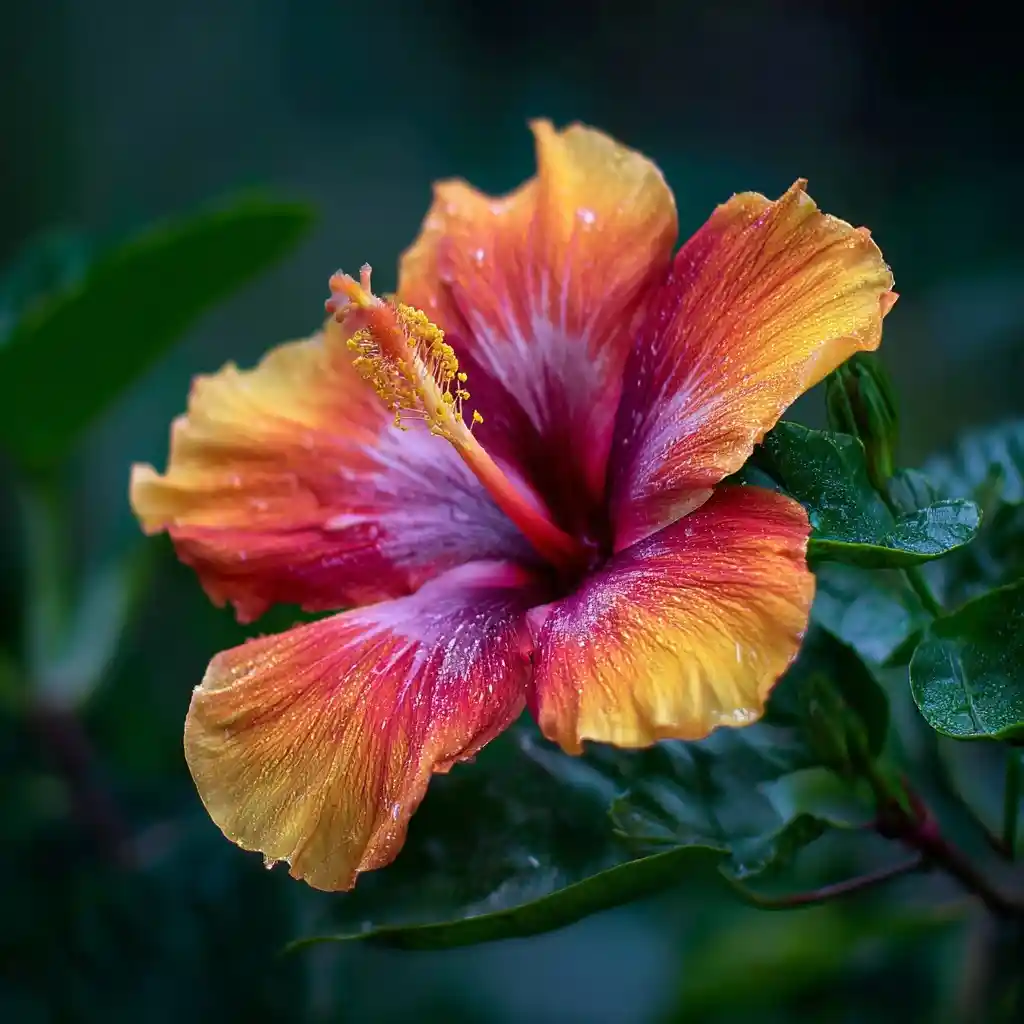
True to its mystical name, ‘Voodoo Queen’ puts on a magical floral show. This hibiscus flower opens each morning in a reddish-orange tone with a deep purple center and a vibrant red throat. By afternoon, the petals shift to golden yellow and lavender-gray, creating a completely different look within a single day.
The seven-inch blooms appear continuously throughout the warm season, set against glossy, dark green foliage. Ideal for containers or in-ground planting in tropical zones, ‘Voodoo Queen’ thrives in full sun and benefits from regular feeding and moisture. Its color-shifting blooms make it a captivating focal point.
Quick Facts:
- Botanical Name: Hibiscus rosa-sinensis ‘Voodoo Queen’
- Zones: 9–11
- Height: 2–4 ft.
- Light: Full sun
- Soil: Moist, well-drained
- Watering: Keep soil consistently moist; fertilize during bloom season
🎄🌸 38. Hibiscus ‘Christmas Angel’
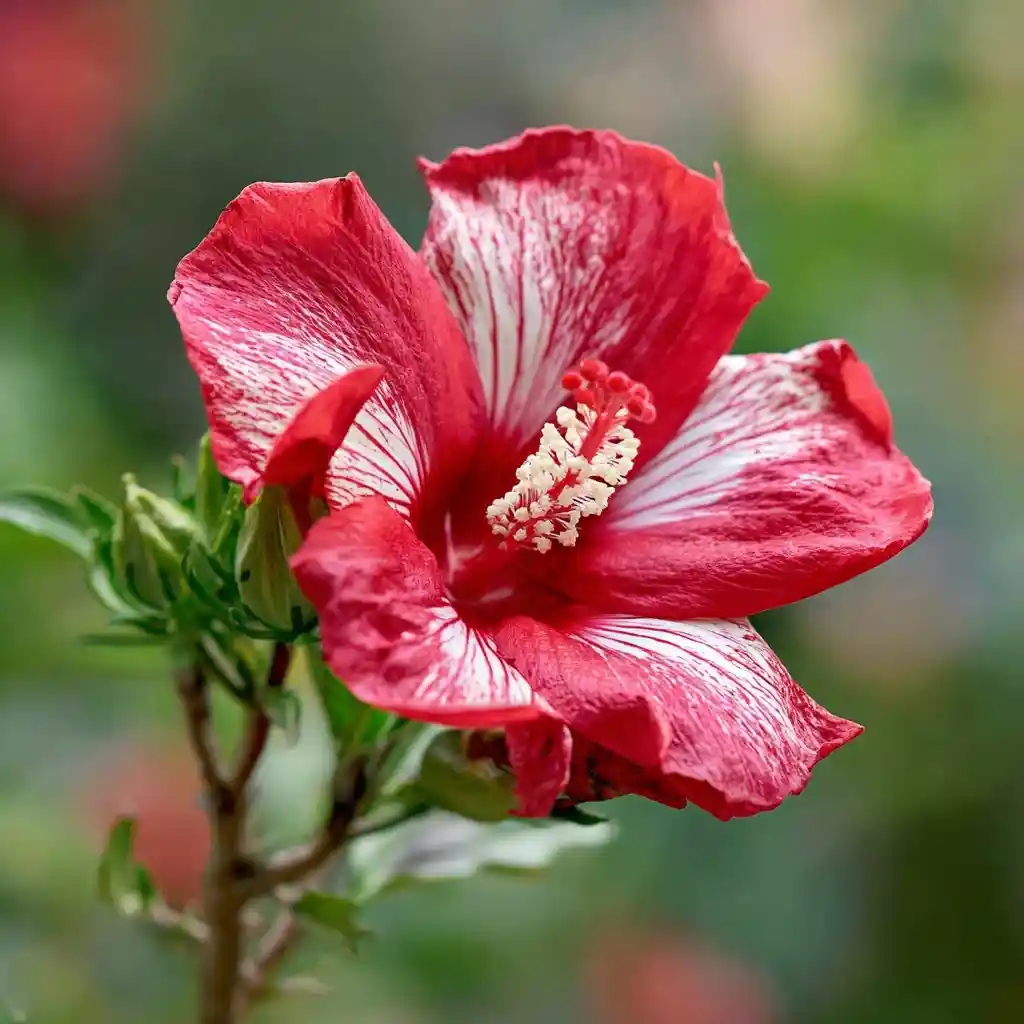
With its joyful color palette, ‘Christmas Angel’ is a festive hibiscus flower variety that lights up any garden. Bright red petals frame a crisp white center, accented by bold white veins that radiate outward like holiday starbursts. It’s a striking contrast that brings energy and brightness to summer landscapes.
This tropical cultivar blooms best in full sun and thrives in consistently moist, well-drained soil. ‘Christmas Angel’ performs beautifully in large containers or as part of a vibrant garden border. In cooler zones, bring it indoors over winter to keep it thriving year after year.
Quick Facts:
- Botanical Name: Hibiscus rosa-sinensis ‘Christmas Angel’
- Zones: 9–11
- Height: 2–4 ft.
- Light: Full sun
- Soil: Well-drained
- Watering: Maintain moist soil; avoid drying out during hot spells
💗🌿 39. Hibiscus ‘Variegated Pink’
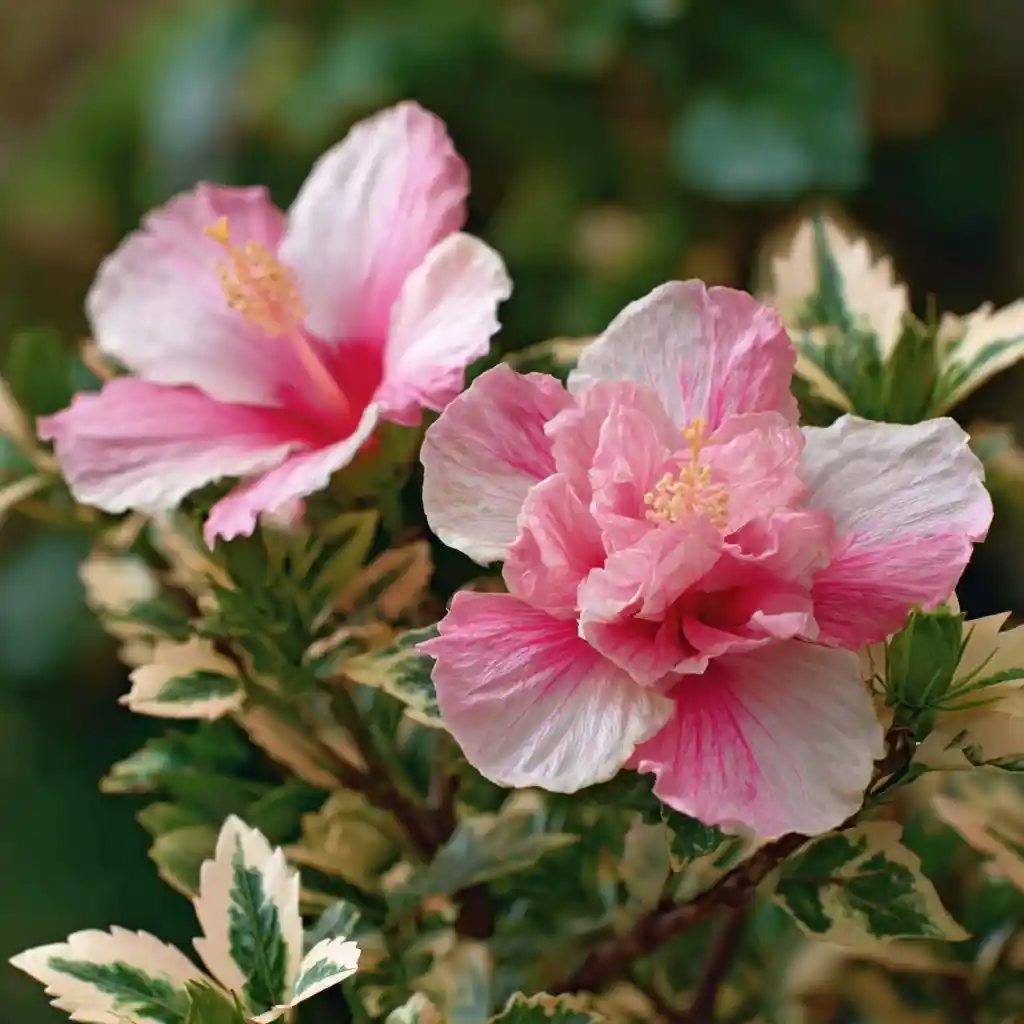
‘Variegated Pink’ is a tropical hibiscus flower that turns heads even when it’s not in bloom. Its gray-green leaves are edged in creamy white, creating a striking variegated backdrop for the soft pink, ruffled flowers. This unique foliage provides year-round visual interest, especially in container gardens or patio displays.
The blooms themselves are delicate yet abundant, making this plant a dual-purpose beauty—ornamental foliage and showy flowers. ‘Variegated Pink’ grows best in full sun and needs rich, moist, well-drained soil. It’s compact and ideal for small spaces, adding charm to porches, entryways, or tropical-themed borders.
Quick Facts:
- Botanical Name: Hibiscus rosa-sinensis ‘Variegated Pink’
- Zones: 9–11
- Height: 2–3 ft.
- Light: Full sun
- Soil: Moist, well-drained
- Watering: Keep moist but not soggy; water more in high heat
🔥🤍 40. Hibiscus ‘White Hot’
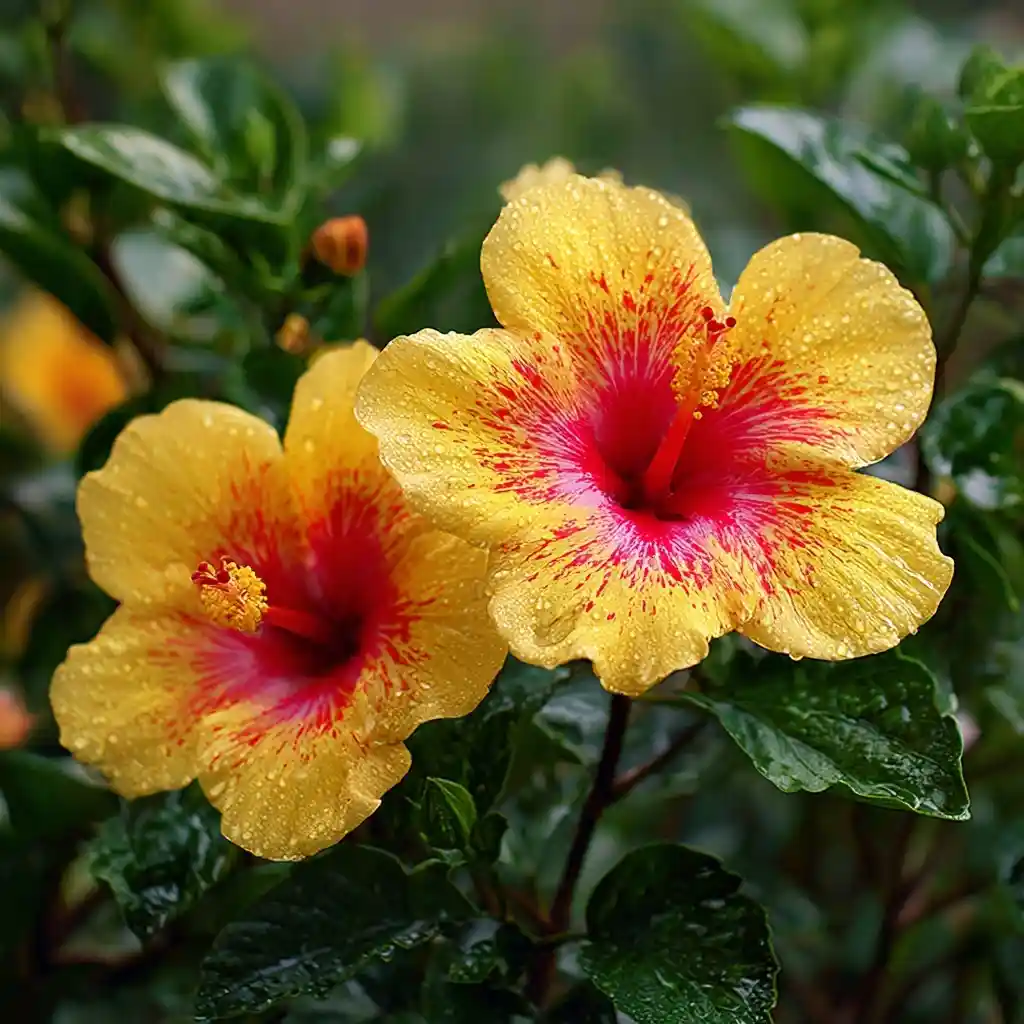
True to its name, ‘White Hot’ delivers fiery flair with its seasonally shifting hibiscus flowers. In spring and fall, the blooms are deep red with yellow speckles and a white center. As temperatures rise, they transform into bright yellow blossoms with warm orange-red undertones—offering a completely different look depending on the season.
This upright, bushy shrub is a tropical favorite for dynamic color in warm-climate gardens. Plant it in full sun to bring out its boldest hues, and give it plenty of space to shine. Whether in a large container or sunny flower bed, ‘White Hot’ is all about visual impact.
Quick Facts:
- Botanical Name: Hibiscus rosa-sinensis ‘White Hot’
- Zones: 9–11
- Height: 2–4 ft.
- Light: Full sun
- Soil: Loam or sandy loam, well-drained
- Watering: Keep soil consistently moist during hot spells
👑🌺 41. Hibiscus ‘Queen of Dreams’
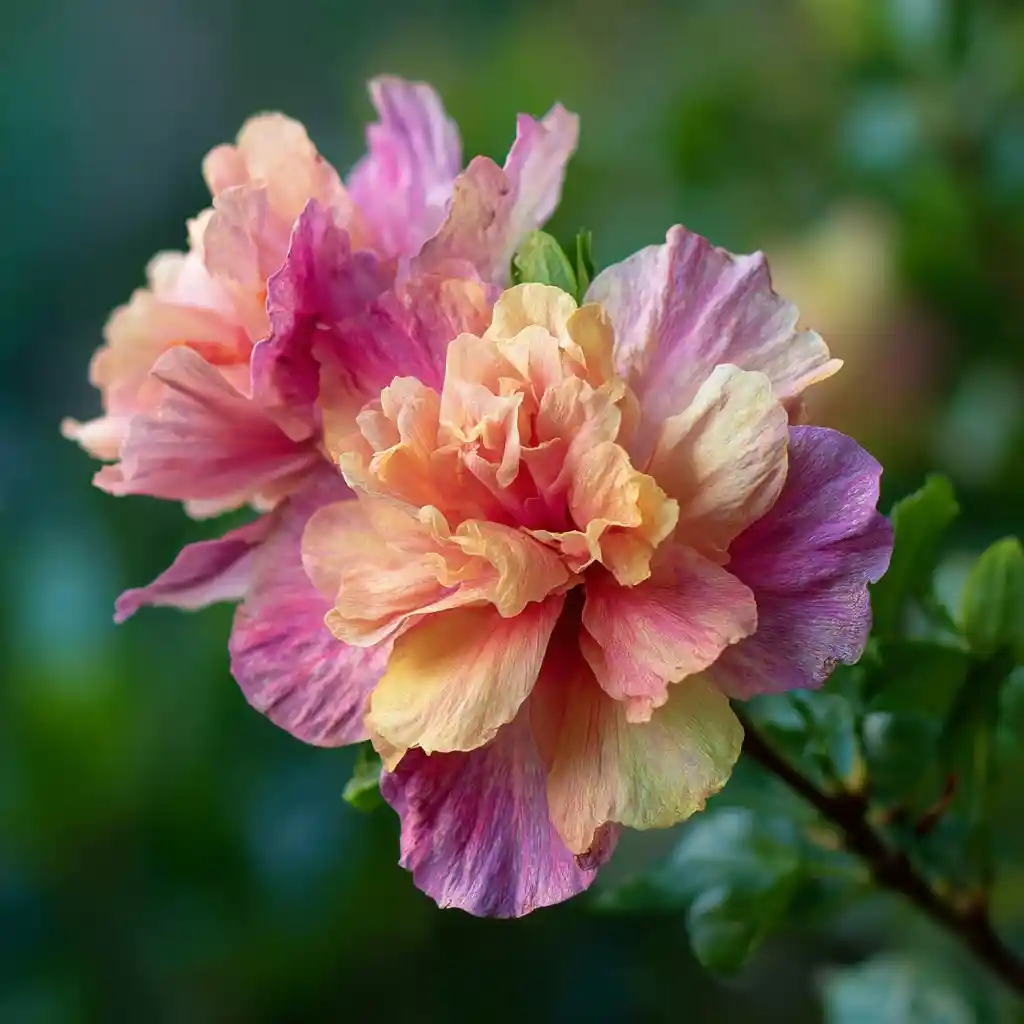
Fit for royalty, ‘Queen of Dreams’ is a rare, multicolored double hibiscus flower that brings elegance and fantasy to any garden. Its frilly, oversized blooms shift through a dreamy mix of peach, pink, rose, and lavender—often all on the same flower. The layered petals create a full, lush effect that’s as regal as its name suggests.
This compact cultivar grows beautifully in containers and thrives in warm, sunny spots. To keep blooms coming, provide regular moisture and a balanced fertilizer during the growing season. It’s a favorite among collectors and anyone looking to add a touch of whimsy to the landscape.
Quick Facts:
- Botanical Name: Hibiscus rosa-sinensis ‘Queen of Dreams’
- Zones: 9–11
- Height: 2–4 ft.
- Light: Full sun
- Soil: Well-drained
- Watering: Maintain moist soil; do not allow to dry out completely
🌺🌴 42. Hibiscus ‘Kona’

‘Kona’ is a charming double hibiscus flower cultivar with soft, frilly blooms that shift between shades of pale and vibrant pink. Its compact growth habit and continuous blooming make it a favorite for containers, sunny balconies, or garden borders that need steady color throughout the warm months.
This tropical variety thrives in full sun and light, well-drained soil. The flowers appear consistently rather than in bursts, making ‘Kona’ a reliable choice for long-season interest. Regular watering and light feeding during the bloom period will keep it thriving and flowering non-stop.
Quick Facts:
- Botanical Name: Hibiscus rosa-sinensis ‘Kona’
- Zones: 9–11
- Height: 2–4 ft.
- Light: Full sun
- Soil: Light, moist, well-drained
- Watering: Keep soil evenly moist; don’t let it dry out completely
🔥🌼 43. Hibiscus ‘Flameball’

‘Flameball’ lives up to its fiery name with fluffy, double blooms in bold orange streaked or edged with bright yellow. This tropical hibiscus flower bursts into bloom during the height of summer, with flowers reaching up to five inches wide. Its hot color palette brings warmth and energy to any landscape.
Ideal for containers or sunny garden beds, ‘Flameball’ prefers full sun and well-drained soil. In cooler zones, it can be grown as an annual or overwintered indoors. Regular watering during peak bloom ensures vibrant flowers and healthy growth.
Quick Facts:
- Botanical Name: Hibiscus rosa-sinensis ‘Flameball’
- Zones: 9–11
- Height: 2–4 ft.
- Light: Full sun
- Soil: Well-drained
- Watering: Keep soil evenly moist; reduce slightly in fall and spring
🌑🌺 44. Hardy Hibiscus ‘Midnight Marvel’

‘Midnight Marvel’ is a bold, garden-ready hibiscus flower hybrid that combines intense color with cold-hardiness. Its huge, deep red blooms—each up to 9 inches across—stand out dramatically against dark, purple-green foliage. As one of the most striking hardy varieties, it delivers tropical flair without needing a tropical climate.
This shrub thrives in consistently moist soil and performs beautifully in sunny garden beds, borders, or near water features. It blooms from midsummer into early fall, bringing long-lasting color to late-season landscapes. Its compact form makes it perfect for small gardens and perennial beds.
Quick Facts:
- Botanical Name: Hibiscus moscheutos ‘Midnight Marvel’
- Zones: 4–9
- Height: 4–5 ft.
- Light: Full sun to partial shade
- Soil: Moist, well-drained
- Watering: Water deeply and regularly to maintain even moisture
🌺 Conclusion
Whether you’re gardening in the tropics or braving cold winters, there’s a hibiscus flower that will thrive in your space. From the towering elegance of Midnight Marvel to the compact charm of Lil Kim, hibiscus offers something for every gardener — vibrant color, pollinator appeal, and even edible varieties like Roselle.
By choosing the right type for your climate and space, and by maintaining moist, well-drained soil and plenty of sunlight, you’ll enjoy a long season of stunning blooms. Don’t forget: hibiscus flowers not only enhance curb appeal but also bring life, color, and joy to any garden setting.
🌿 Love gardening inspiration? Follow me on Pinterest for bold plant ideas, tips, and seasonal color!
More Posts

